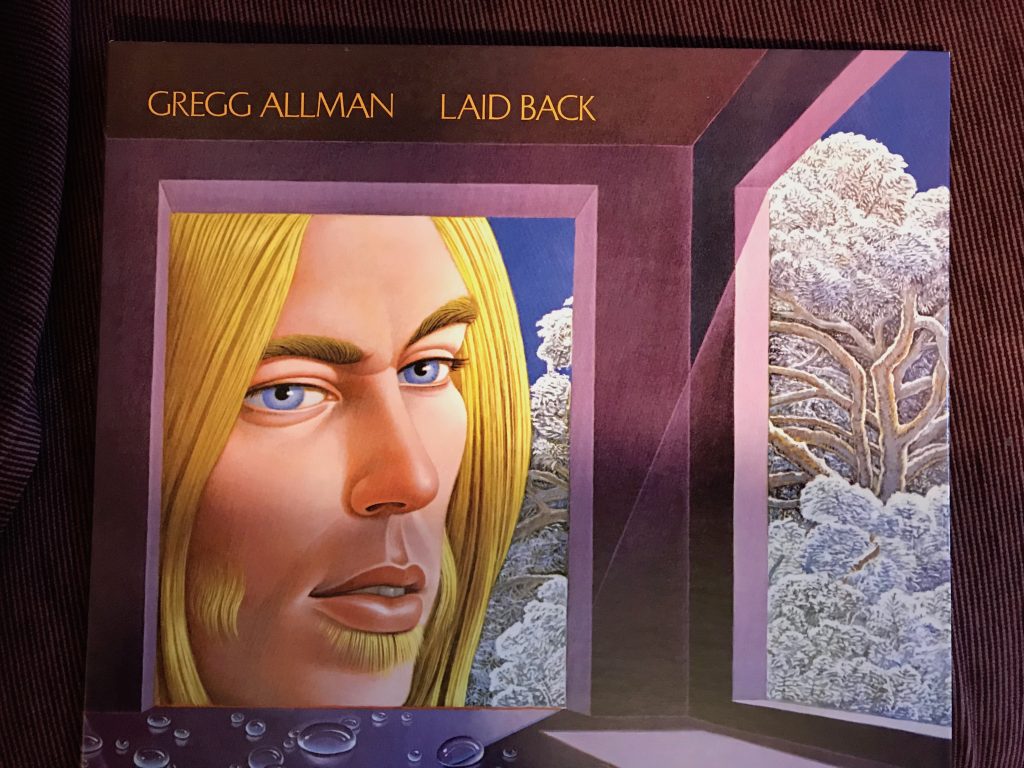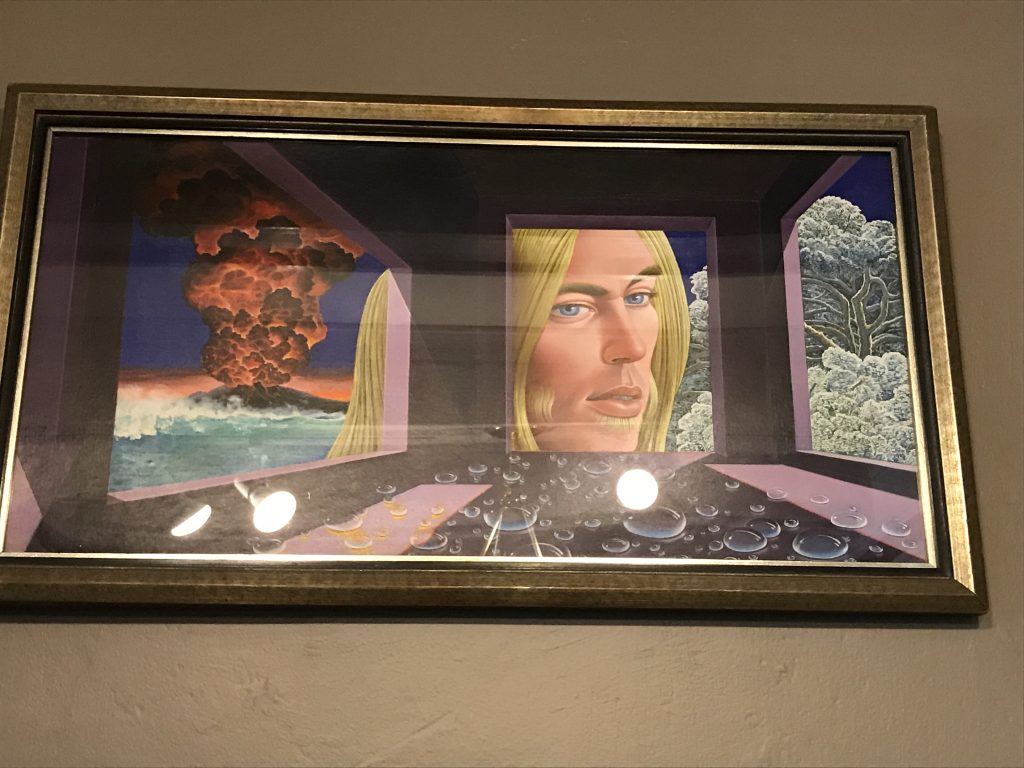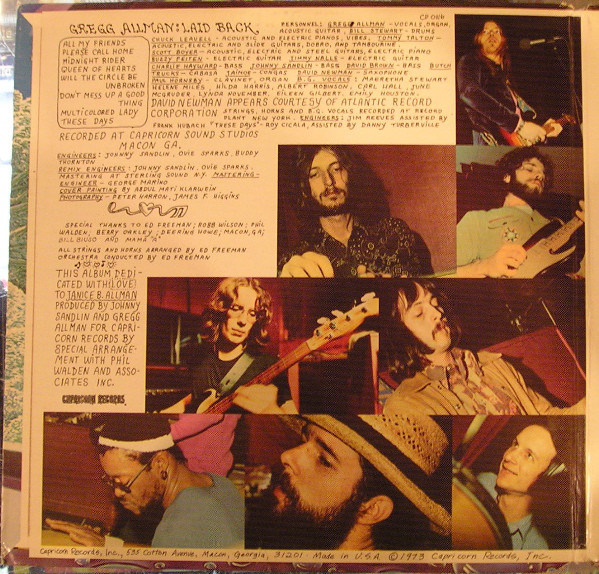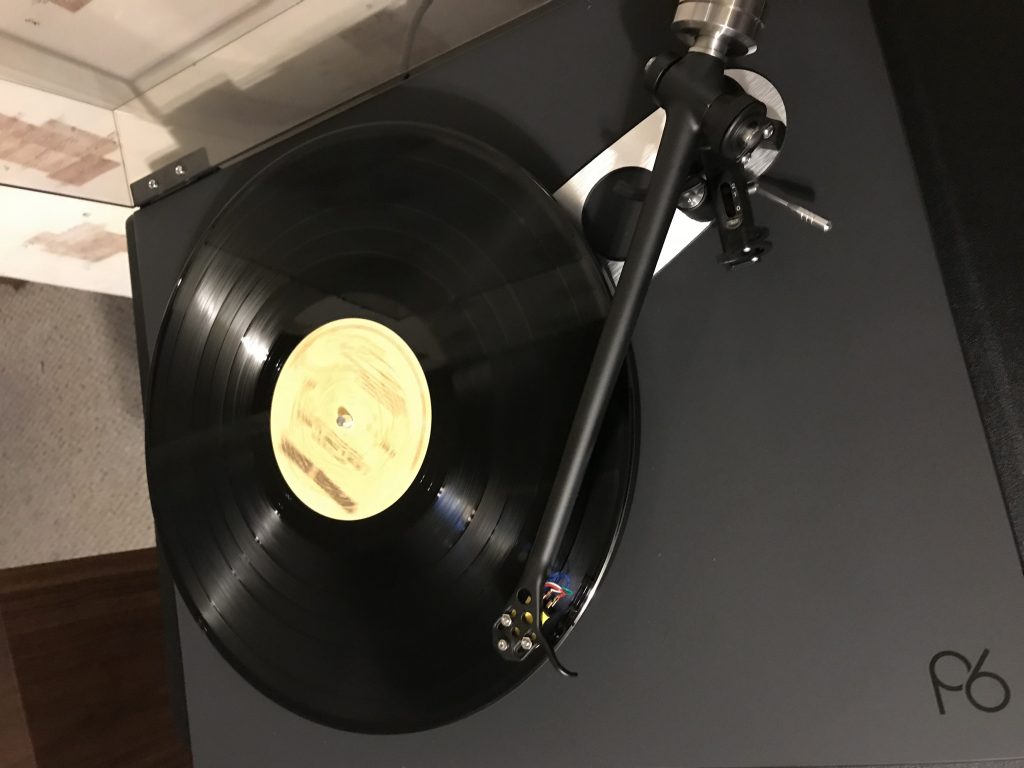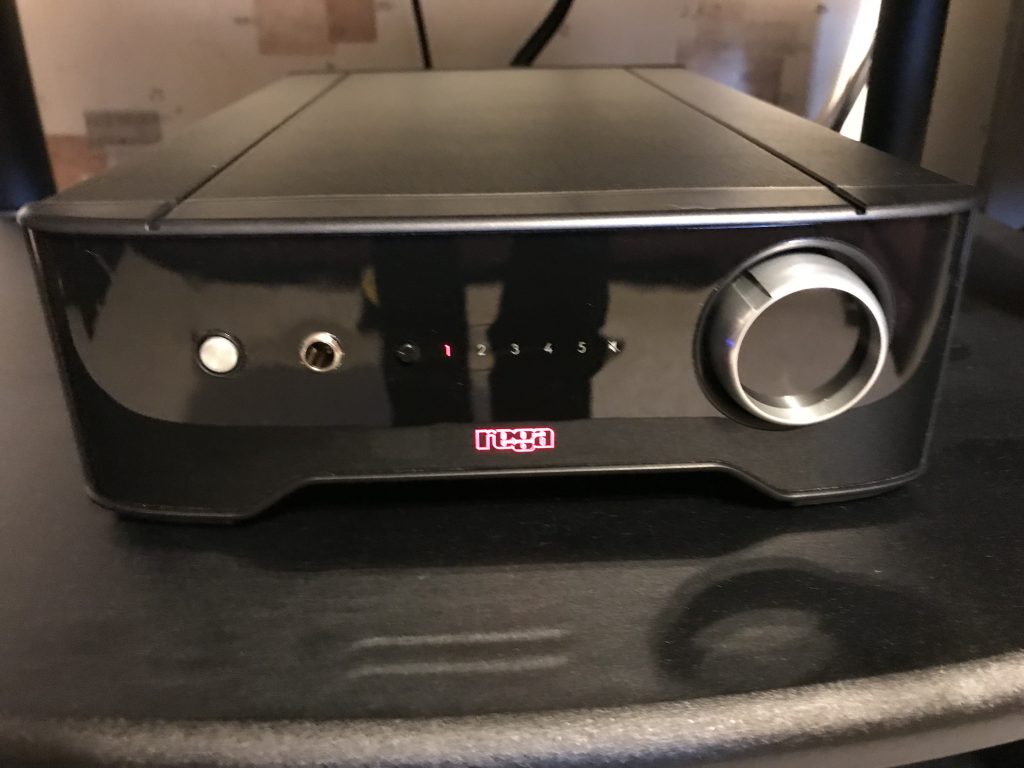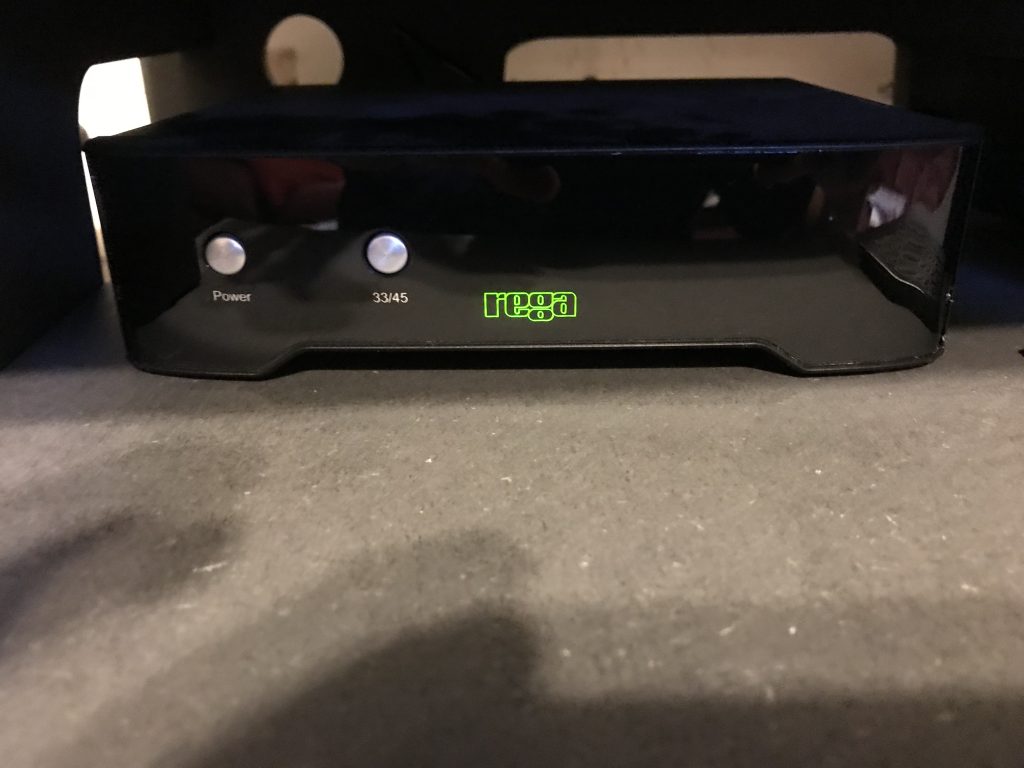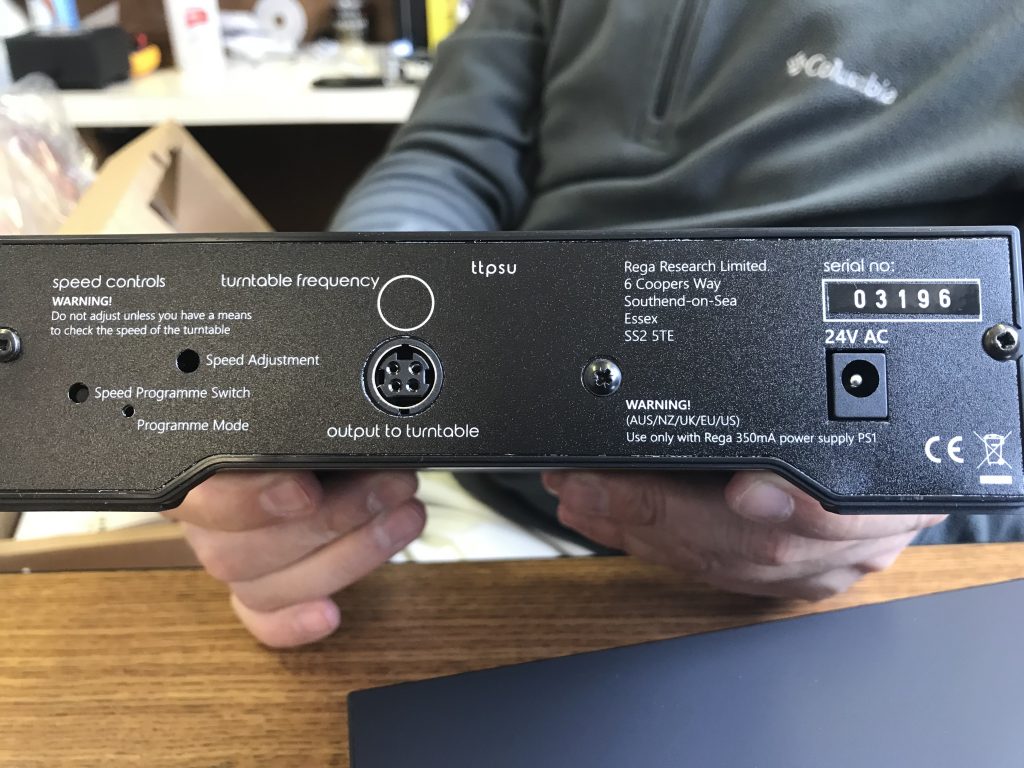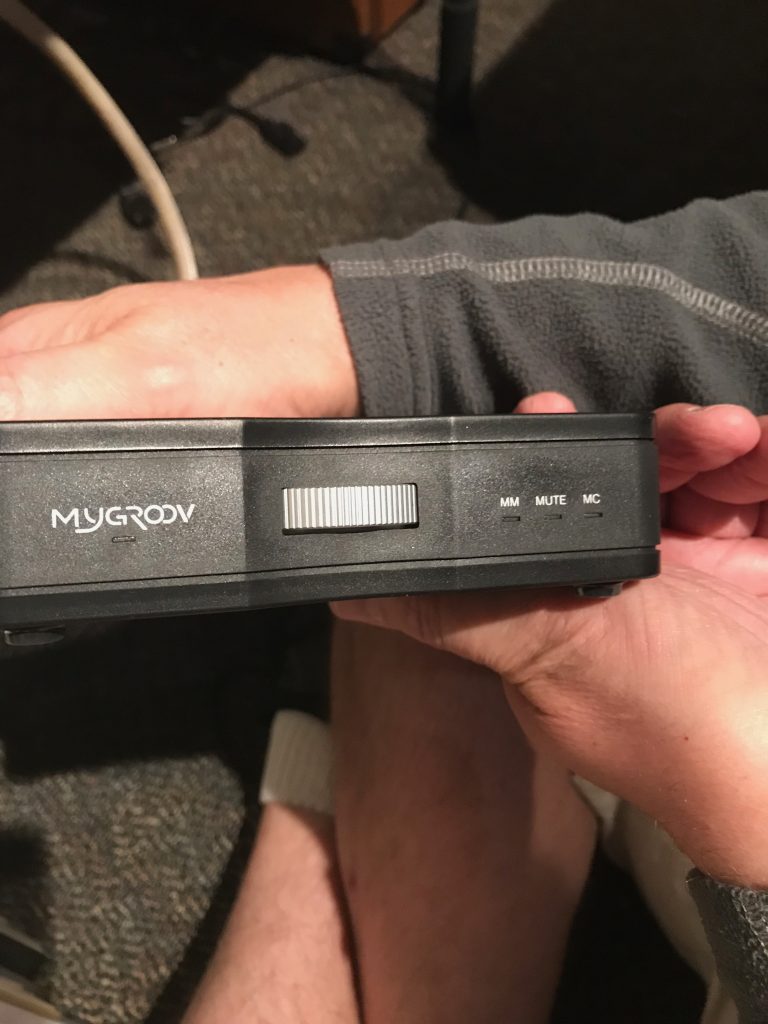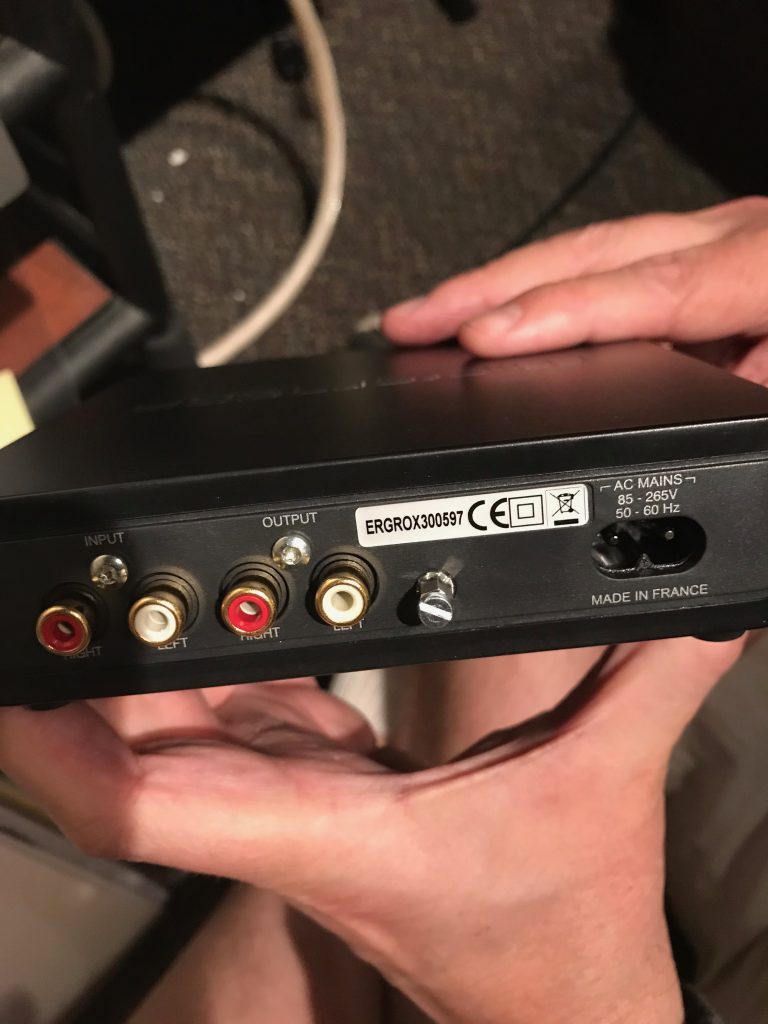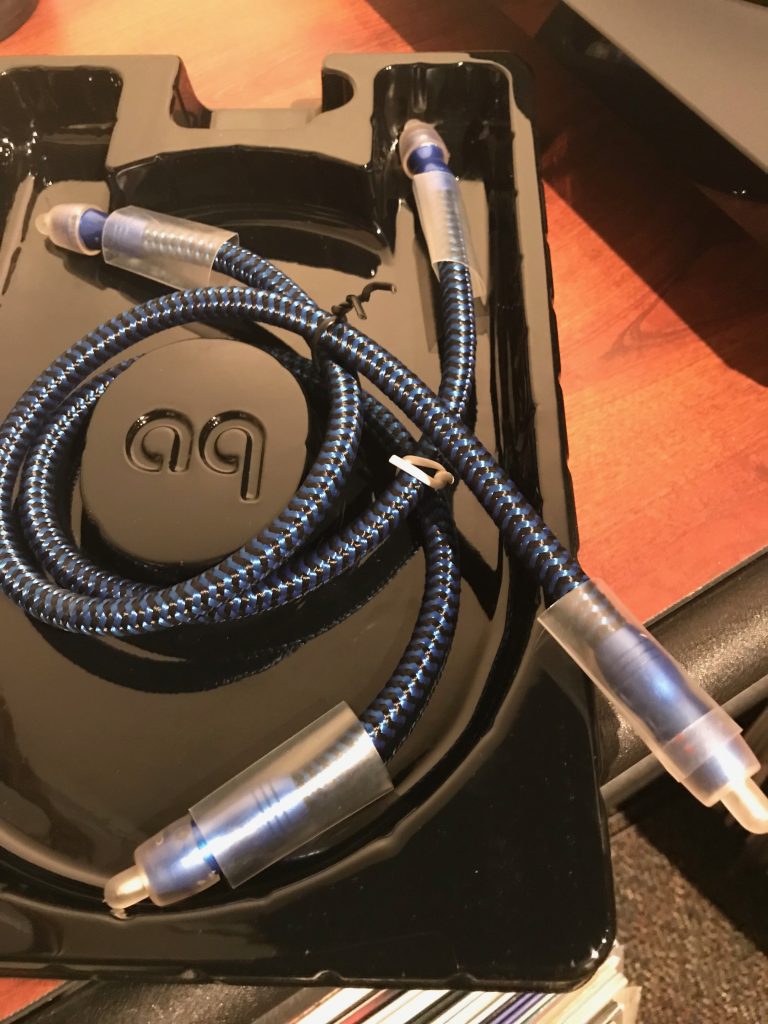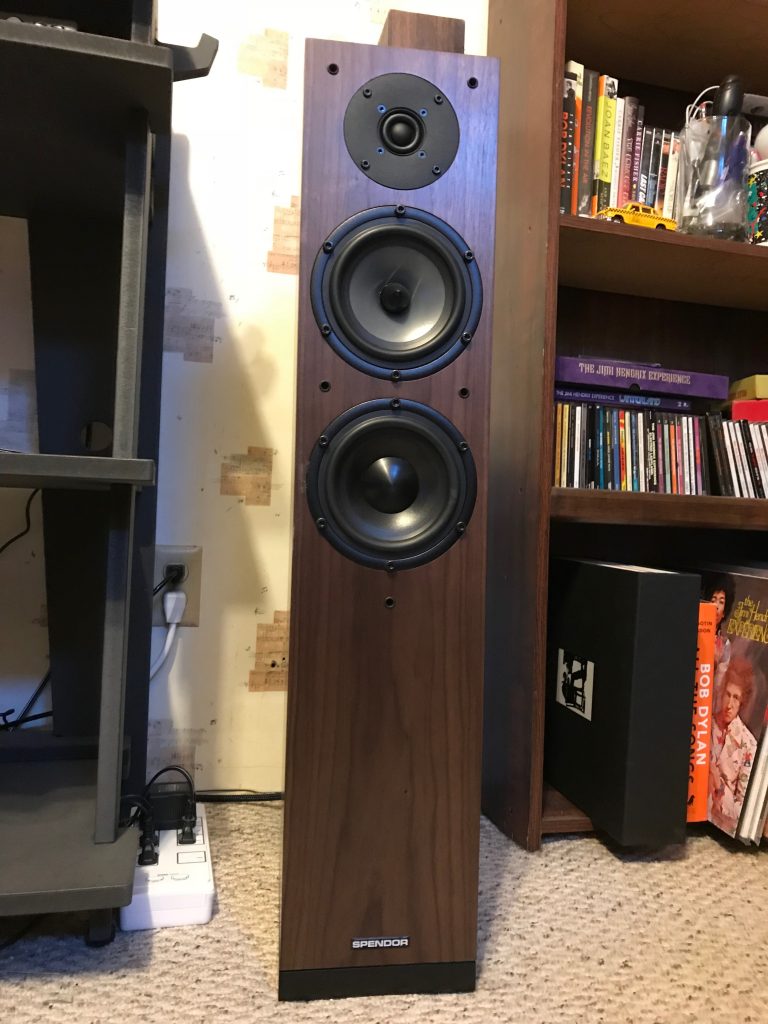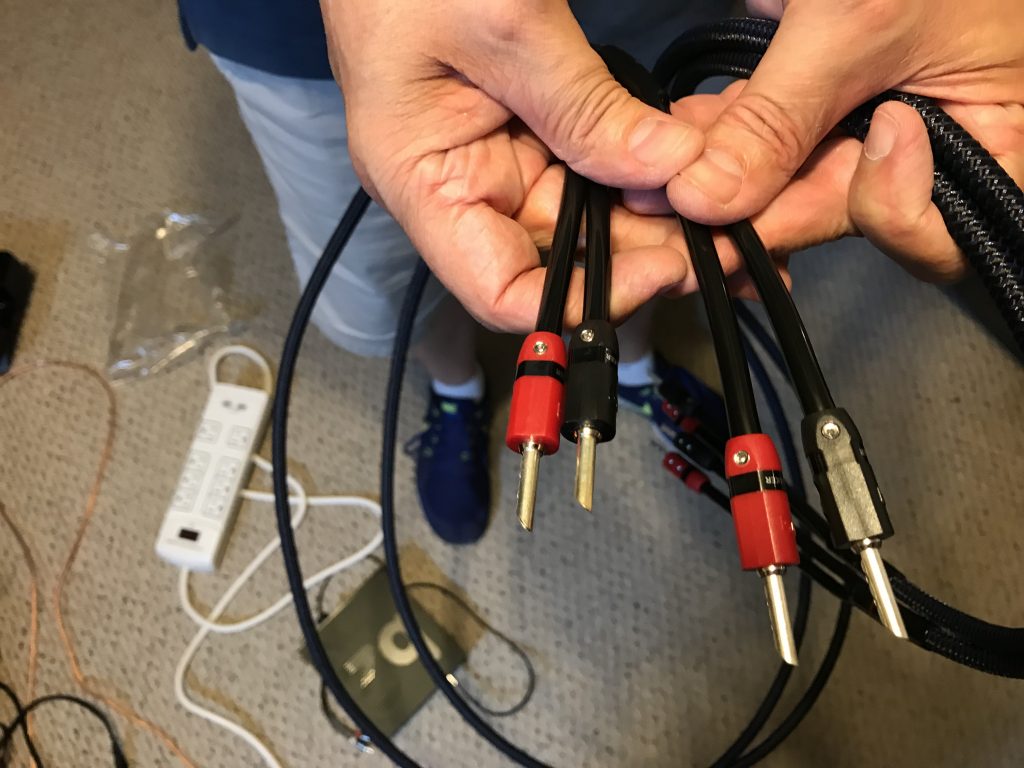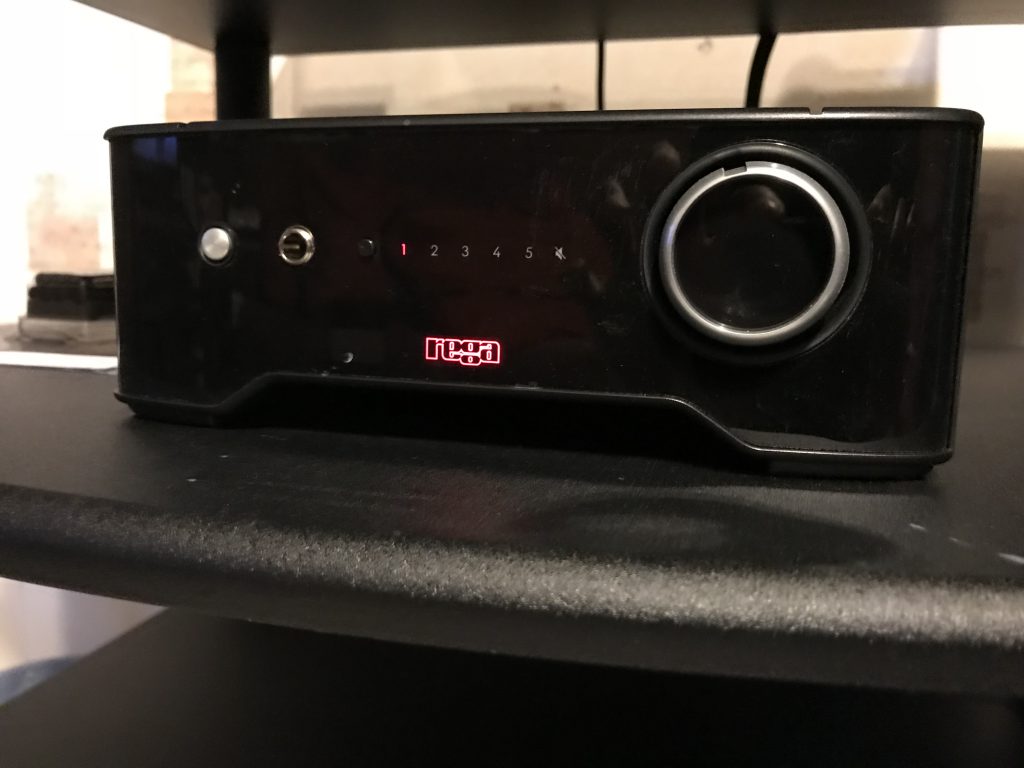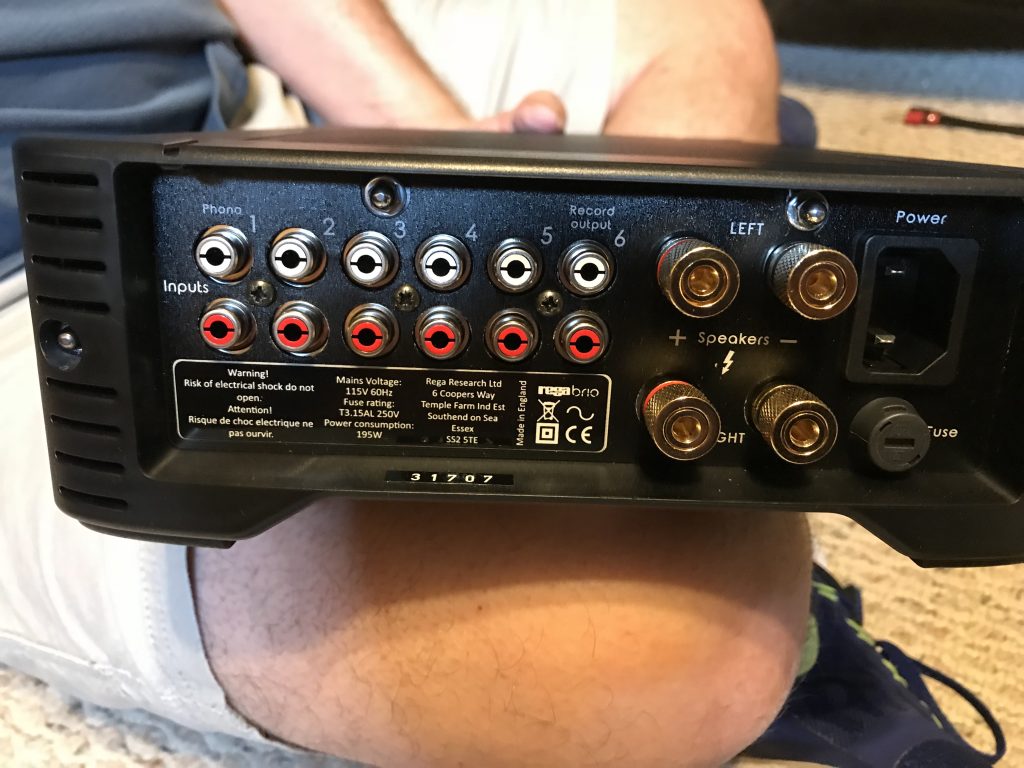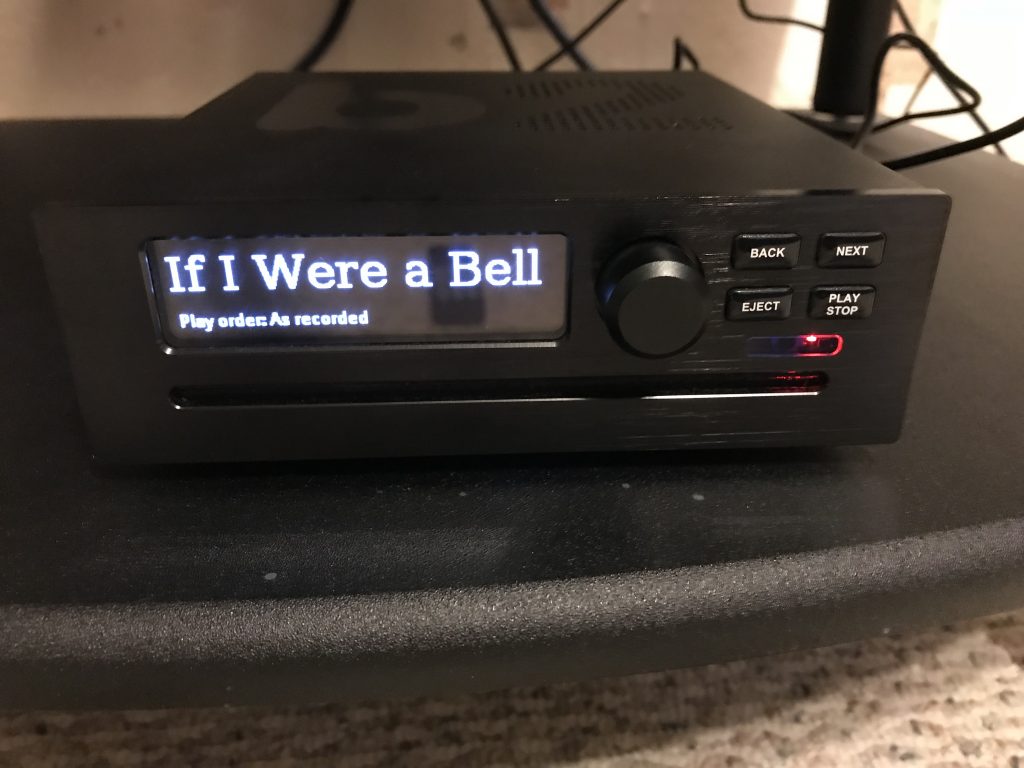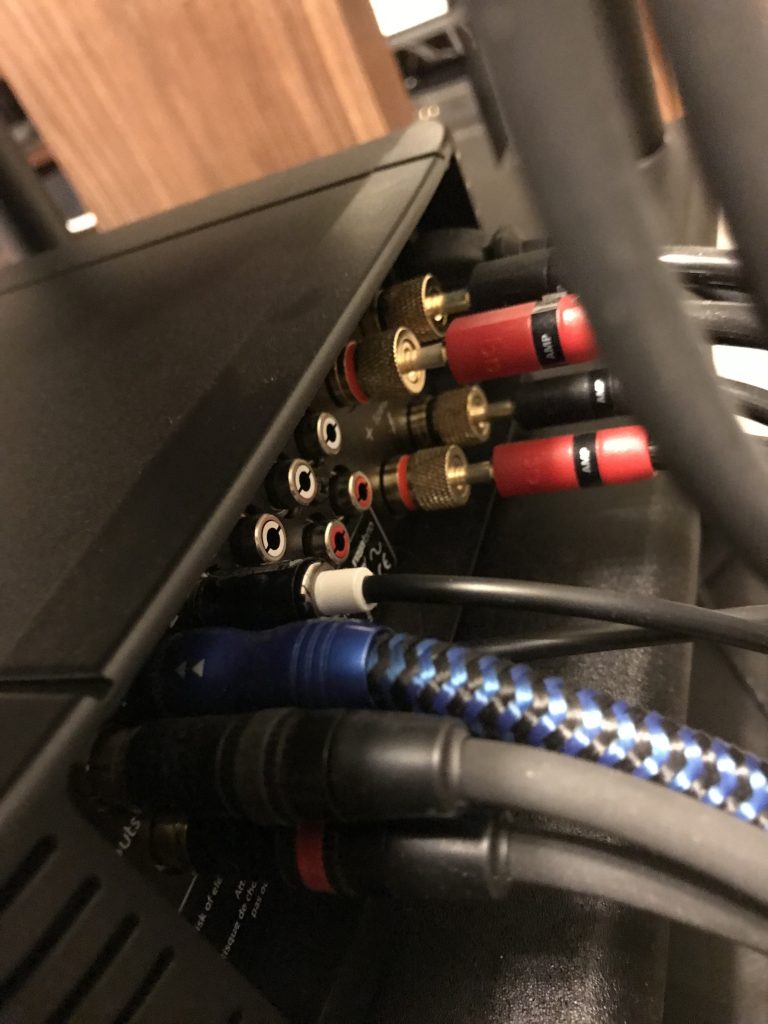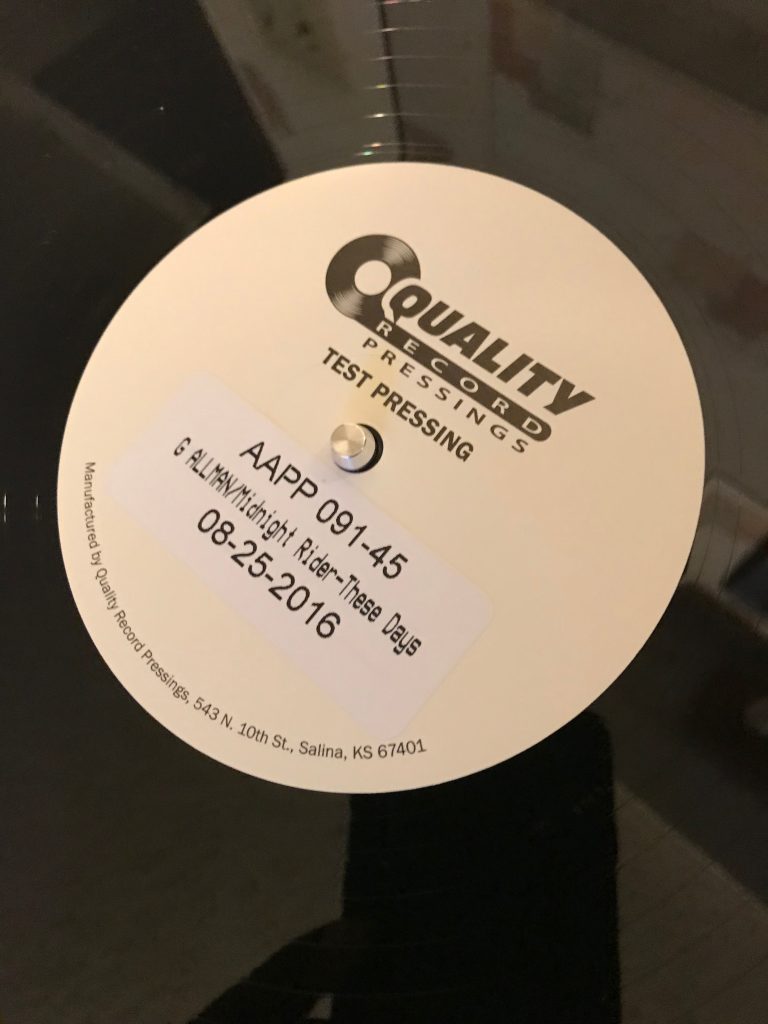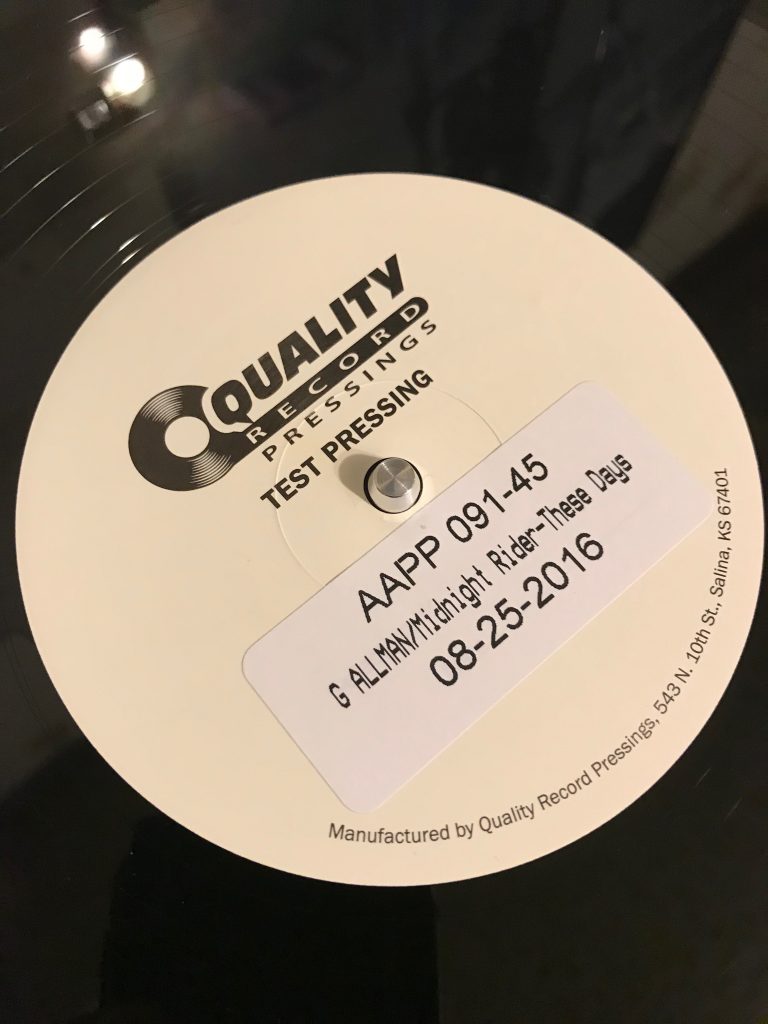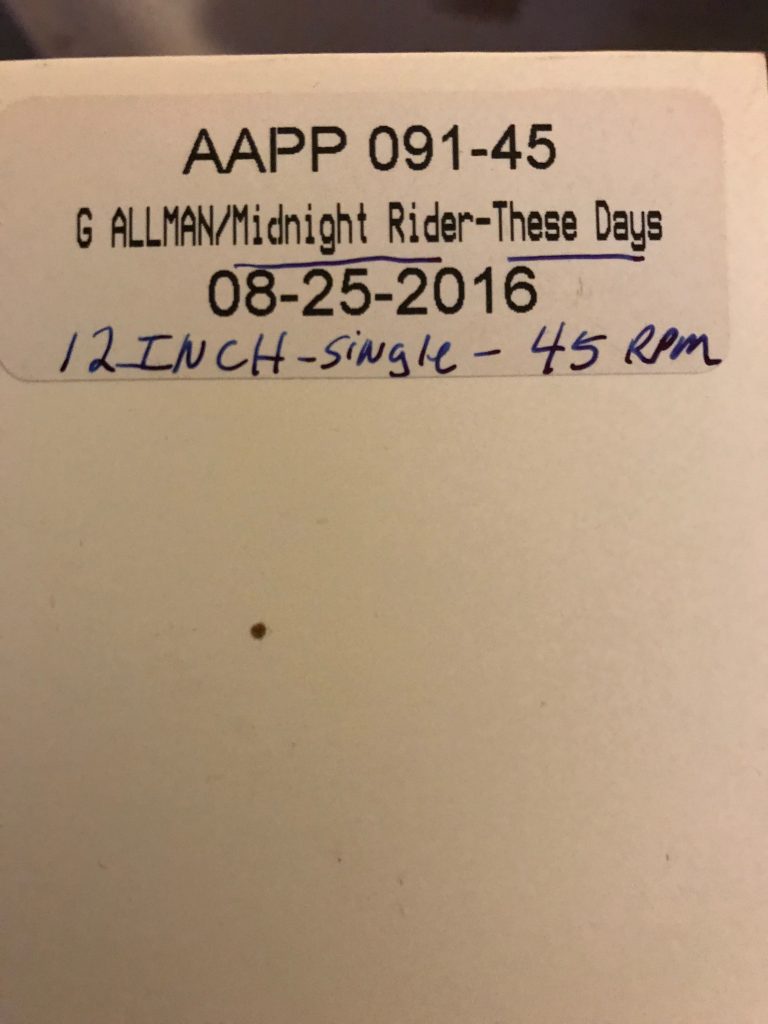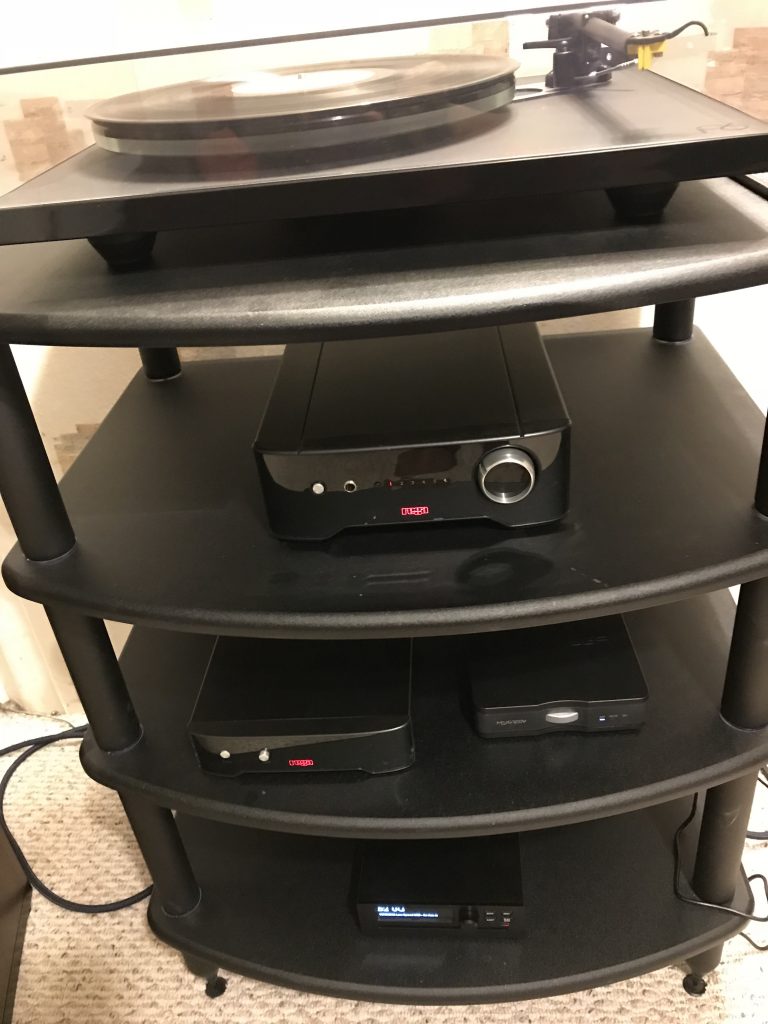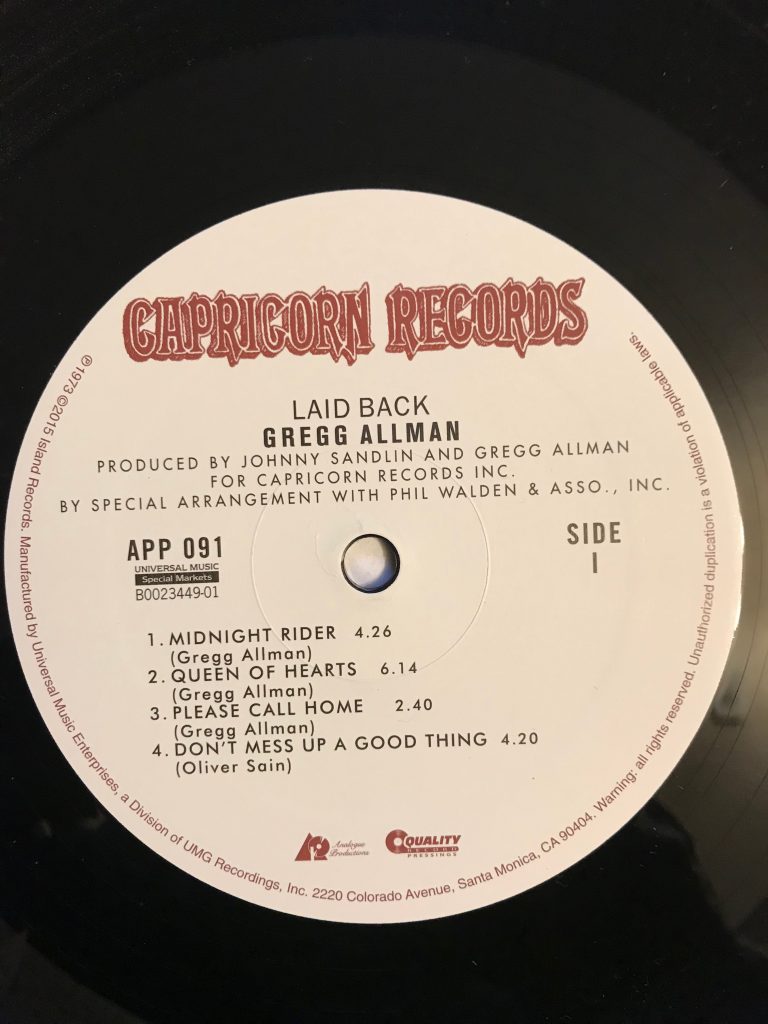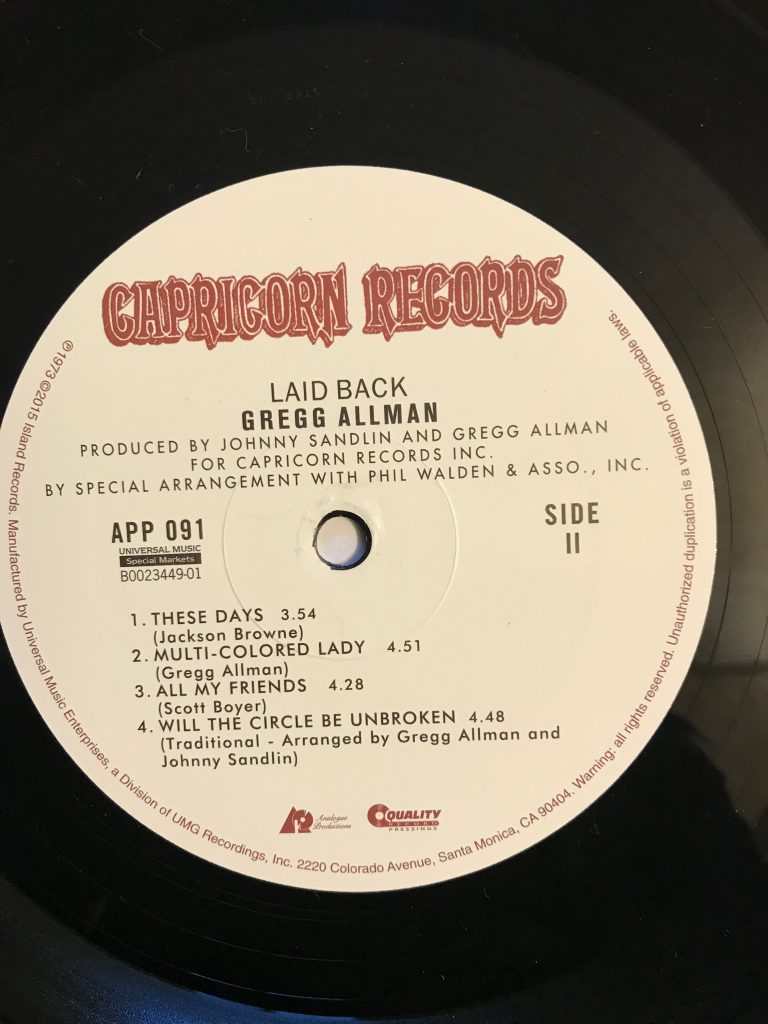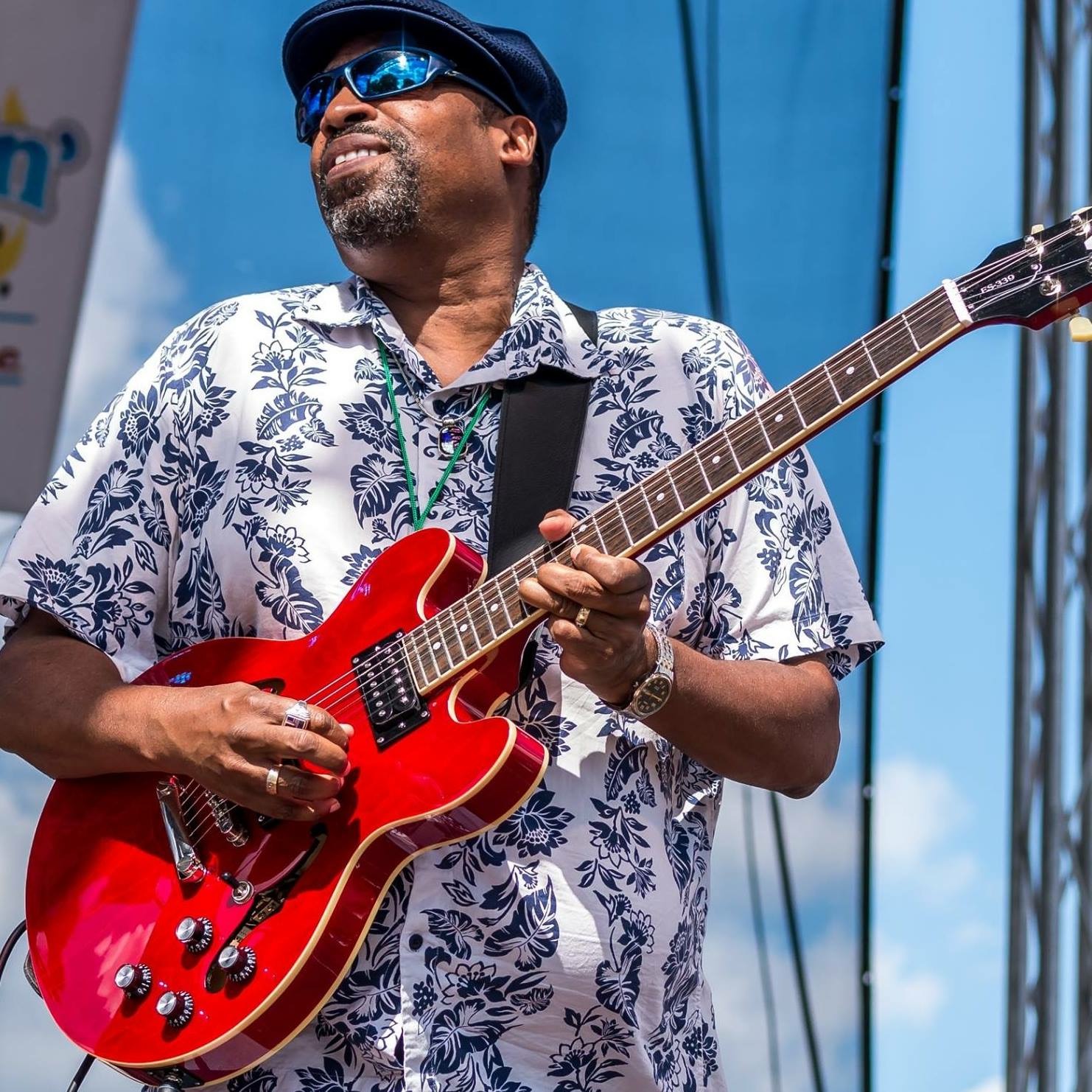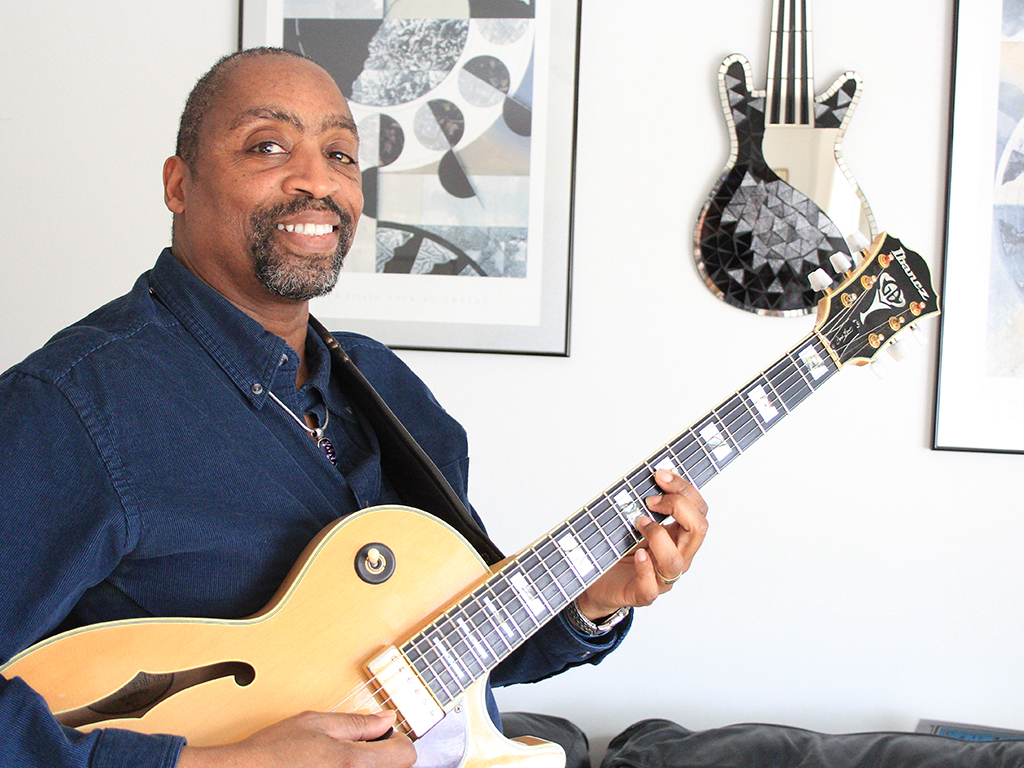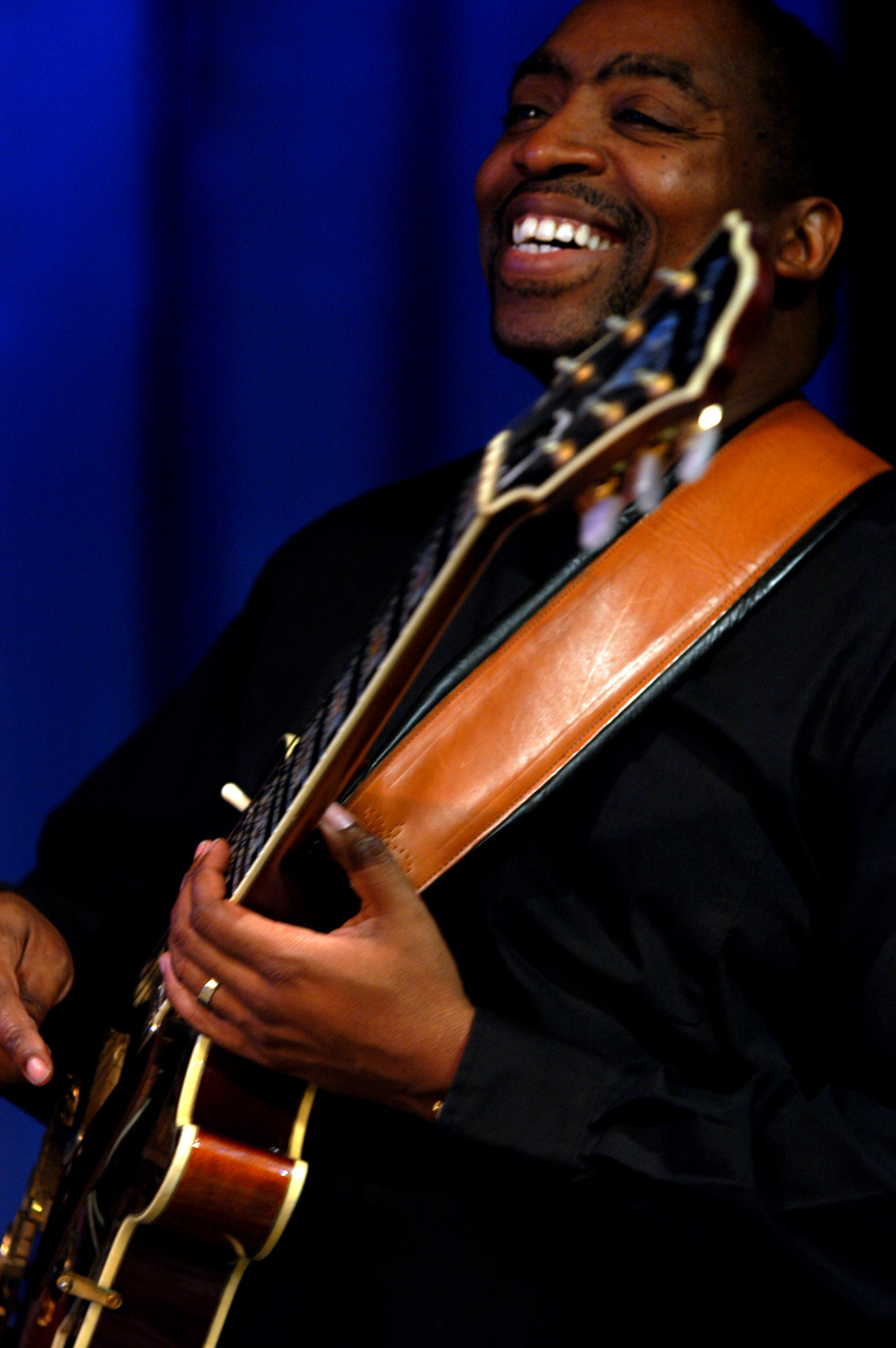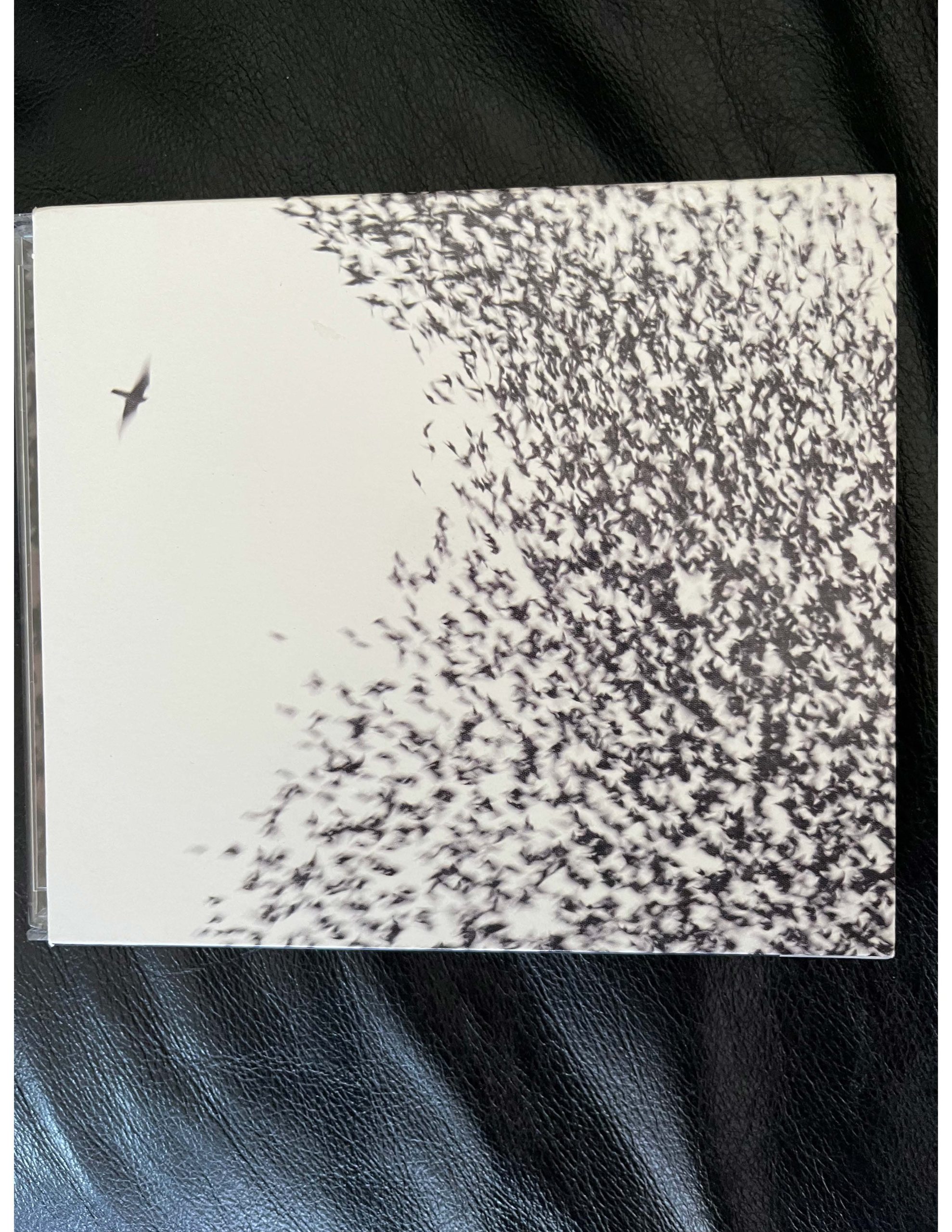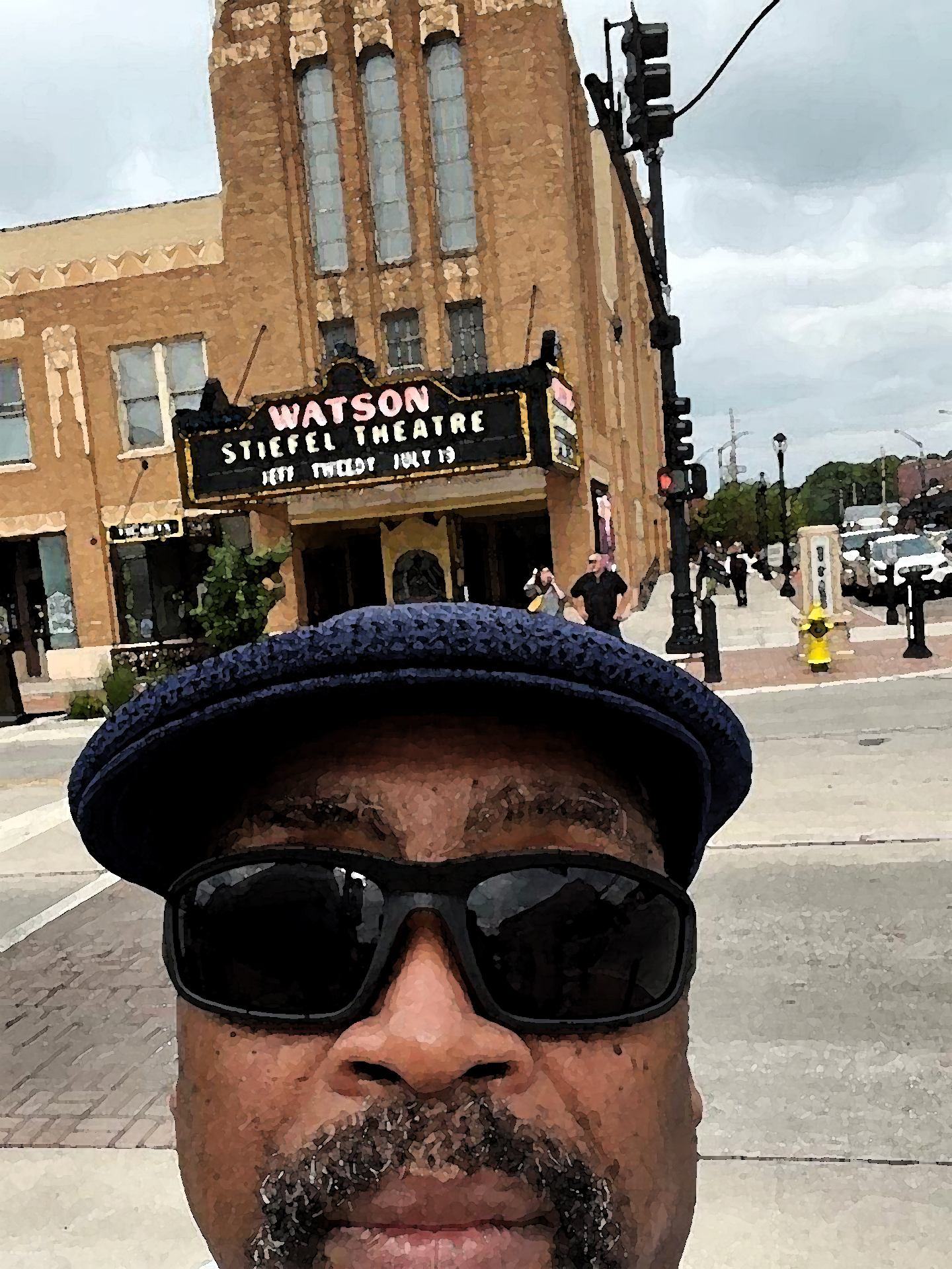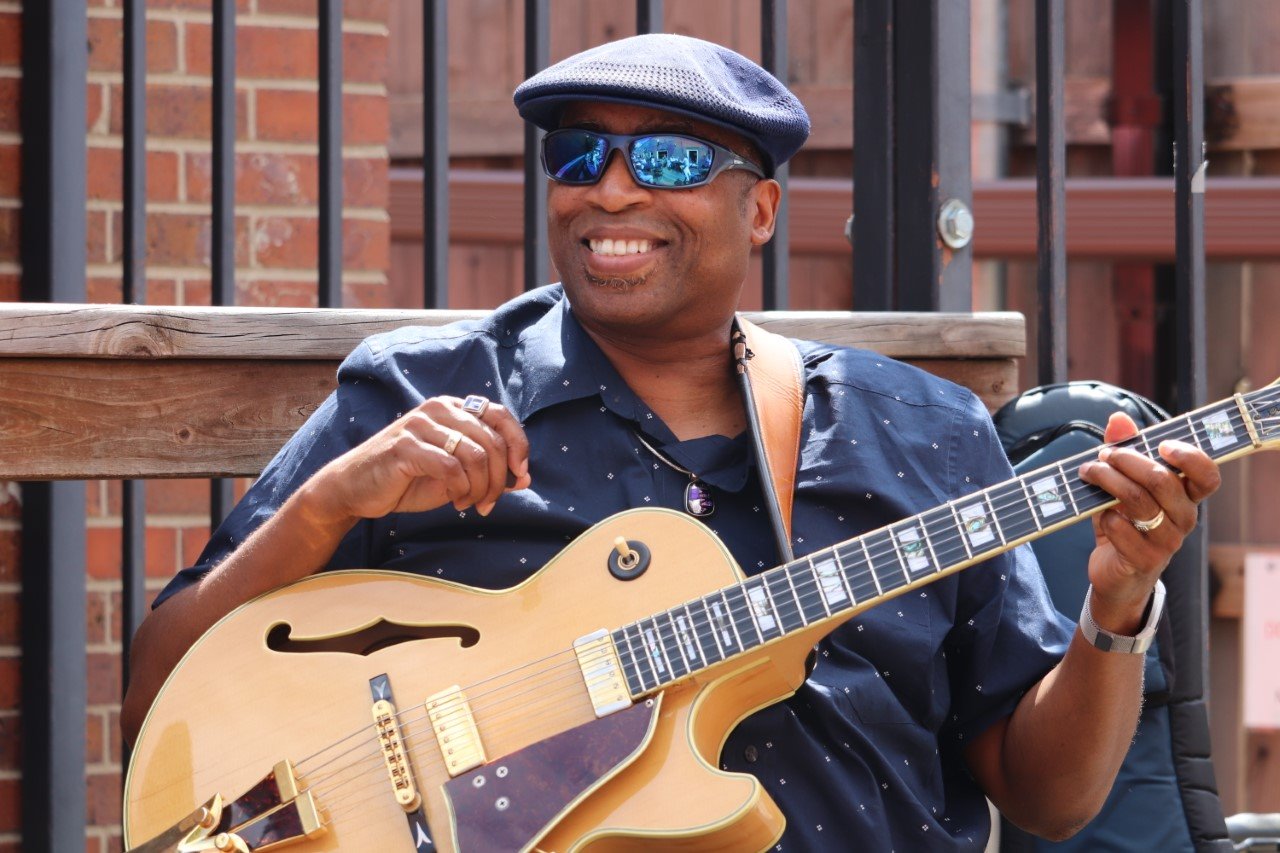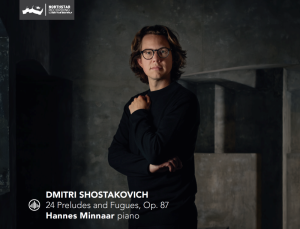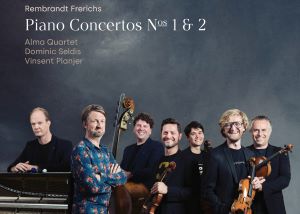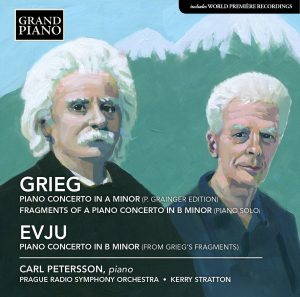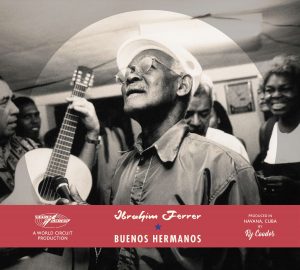"Laid Back is a masterpiece! Gregg's greatest solo album and I'd be shocked by anyone disagreeing with that!" - Alan Paul, author of One Way Out: The Inside History of the Allman Brothers Band.
"Laid Back is probably the finest record Capricorn released in the post-Duane Allman era." - Scott Freeman, author of Midnight Rider: The Story of the Allman Brothers Band.
Part 1 - The Makings of Laid Back
Eat A Peach was a landmark album for the Allman Brothers, and was forever associated with the death of guitar legend Duane Allman. The double album Eat A Peach was named after a phrase Duane coined from a line in the poem by A.J. Prufrock, and not—as so many have been misled to believe over the years—labeled after the kind of truck that caused his motorcycle accident.
While Live at the Fillmore was released in July 1971 and quickly became their first million-seller, Eat A Peach had been only partially completed when that ill-fated crash occurred. And yet well after the album was released in February 1972, Gregg Allman was still mourning the passing of his brother when the fall season approached. By then, the Allman Brothers were working on a follow-up to the huge success of Eat A Peach.
Based on their success, the band positioned themselves to renegotiate the terms of their contract with Phil Walden, the owner of Capricorn Records, whose office was located at 535 Cotton Avenue, with the recording studio situated at 548 Broadway in Macon, Georgia. As one of the bargaining chips that stood in the band's favor, "part of their deal was that they got free studio time at Capricorn," said Johnny Sandlin, the engineer, drummer, bassist and producer who worked for Walden's studio. The band took full advantage of the new deal, which was signed on November 1, according to biographer Scott Freeman. The Allman Brothers began rehearsing some new material that might go on the next album—which eventually became Brothers and Sisters, an LP that would not only eclipse Eat a Peach, but also surpass anything before or after it during the band's illustrious history.
Gregg—who was always the most productive and prolific writer in the band—had collected a handful of tunes that didn't seem to fit the personality and reputation of the ABB. More appropriately, they reflected his own brand of style and sensibility, and even more, his growing sense of melancholy, which clung to him like a cloak now that his brother was gone. Indeed, his overall state of mind permeated Laid Back through and through, which ultimately set it apart from the "other" album they were working on simultaneously.
This made for a perfect opportunity for producer Johnny Sandlin, who said in his autobiography, "I'd always wanted to do a solo album with Gregg and feature him in a different light from what he was doing with the Brothers. To me his voice sounds best on blues and on his own songs."
Things got off to a shaky start when Gregg first presented to ABB a rough sketch of a song called "Queen of Hearts" that he'd been crafting over a year and a half before. It had a section that was in mixed-meter time, 11/4, the same time signature as in the popular tune, "Whipping Post" he'd written for their first album. The band did not like it and gave no respect to it, especially since Gregg himself was struggling personally with alcohol and drugs. "That song just ain't sayin' nothin'," they said.
Gregg was disappointed and upset because the band didn't take him seriously—they dismissed him and his songs out of hand. Then again, he realized they'd maybe done him a favor. It led to his first solo album—it was all the reason he needed to do it. He had an entire album's worth of material that wasn't going to be of any use to ABB, and he'd need to work independently to see the project to fruition.
And work he did. "I did two sessions back to back," he wrote in his autobiography. "One was 42 hours and after I got about six hours of sleep, I went back and did another 28-hour session." Quite naturally, the marathon experience burned him out; he lost perspective, and lost heart. He threw the tapes into the trashcan, then prepared to douse them with lighter fluid and torch them. Johnny Sandlin walked in, saw what was happening and stopped him, then offered to help produce it so that Gregg wouldn't be knocking himself out wearing two hats and serving multiple roles serving as producer, engineer and artist—"trying to work both sides of the glass" as Johnny so aptly described it.
It was in October that sessions earnestly began for the Brothers and Sisters recordings. At the same time, Gregg's tunes were slowly taking shape as well, and the sessions overlapped each other seamlessly. Needless to say, the level of musicianship on both projects was identical, but the similarities ended there—the song compositions and arrangements were quite different. The concept of Gregg's album reflected his general demeanor and overall philosophy on how to be—just "laid back." Sonically speaking, it's how he always preferred things to be when the music and musicians got a bit too heated. It's how you cool it "when the song is in the right tempo, but it has too much energy to it," he said. "Can you make it a little more laid back?" he would ask the guys.
Indeed, he did find several key figures who grasped the concept for his project and approached it with a different demeanor than what was being created in the new ABB sessions. In particular, Gregg was extremely impressed with the keyboard skills of Chuck Leavell. While Chuck was on the road playing in Dr. John's band (who regularly opened for ABB while on tour), he was so intrigued with the music of the Allman Brothers that he would set his keyboard up at every gig in the wings backstage and play right along with them when they were performing on stage. "Gregg remarked that he'd noticed me jamming along and thought that it was pretty cool," Chuck recalled. Gregg admired Chuck's initiative as well as his inventiveness, and recruited him for the Laid Back sessions. Although Leavell had been opening for ABB with Dr. John, he was also being invited to participate in the informal yet frequent ABB studio jams, which eventually turned into formal recording sessions for posterity. He quickly surmised that he was pulling double duty. "The ['Laid Back'] sessions often overlapped [the 'Brothers/Sisters' sessions], and we all hung around the studio an awful lot. Before I knew it, I was working on that too," Chuck said.
Sadly, only ten days after Chuck's first ABB gig, Berry Oakley died in a motorcycle accident almost identical to the manner and location of Duane—it was the only gig he played with Oakley. Lamar Williams was the replacement for Berry Oakley, as he was introduced and invited to audition since he was a high school friend of ABB's drummer Jaimoe back in Gulfport, Mississippi. Lamar had a free, melodic approach to playing that was eerily similar to Berry, which was one of the reasons he won the gig hands down. Oddly enough, the combination of Williams and Leavell gave a fresh charge to all the sessions for Laid Back as well as Brothers and Sisters albums.
"I was really trying not to sound like the Brothers…Chuck made it a lot easier for me to do what I wanted to do with the record." Gregg was so impressed with him that he eventually allowed Chuck wider musical latitude and verbal input as the sessions wore on, and it was a real bonus for both of them - Leavell contributed mightily to the album. "You'd show him something one time and that was it," Gregg said. "He'd give you exactly what you wanted without any questions, and if he embellished a song he made it even better."
This album eventually caused quite a bit of disturbance among ABB members because it was in the direct path of progress of the new album they were working on. The steadily increasing amount of overlap and common denomination regarding the personnel who played on each project became an all-too-obvious issue. Still, Gregg was undeterred. "Laid Back was my mistress…it didn't make the other guys happy…but making that record was something I needed to do." And without saying it too specifically, he was also referring to a need for a special project that would simultaneously exercise his emotional demons, occupy his time and distract him from his woes after losing both his brother Duane and Berry Oakley.
Part 2 - The Platter Matters
Artist: Gregg Allman
Title: Laid Back (33 1/3 RPM)
Label: Analogue Productions
Genre: Pop Rock
Product No: AAPP 091
UPC: 75308800912
Availability: In Stock
Category: 200 Gram Vinyl Record
- Mastered by Ryan Smith at Sterling Sound from the original tapes
- Plated and pressed at Quality Record Pressings
- Faithfully reproduced jacket artwork; tip-on gatefold from Stoughton Printing
Side 1
- Midnight Rider (Allman, Robert Kim Payne) - 4:28
- Queen of Hearts - 6:17
- Please Call Home - 2:48
- Don't Mess Up a Good Thing (Oliver Sain) - 4:13
Side 2
- These Days (Jackson Browne) - 3:56
- Multi-Colored Lady - 4:55
- All My Friends (Scott Boyer) - 4:32
- Will The Circle Be Unbroken (Trad.; arr. by Allman & Johnny Sandlin) - 4:49
Total length: 35:27
Personnel
- Gregg Allman - vocals, organ, acoustic guitar
- Bill Stewart - drums
- Chuck Leavell - acoustic and electric pianos, vibes
- Tommy Talton - acoustic, electric and slide guitars, dobro and tambourine
- Scott Boyer - acoustic, electric and steel guitars, electric piano
- David Brown - bass
- Buzzy Feiten - guitar
- Charlie Hayward - bass
- Paul Hornsby - organ, keyboards, clavinet
- Jaimoe - percussion, conga
- Carl Hall - background vocals
- Hilda Harris - background vocals
- Cissy Houston - background vocals
- Emily Houston - background vocals
- June McGruder - background vocals
- Helene Miles - background vocals
- Linda November - background vocals
- Eileen Gilbert - background vocals
- Maretha Stewart - background vocals
- Albertine Robinson - background vocals
- Jim Nalls - guitar
- David Fathead Newman - saxophone
- Johnny Sandlin - bass
- Butch Trucks - percussion, cabasa
- Ed Freeman - strings and horn arrangements, conductor
- Max Cahn - violin
- Tony Posk - violin
Production
- Johnny Sandlin - producer, arranger, engineer
- David Boyd - personal manager
- Ovie Sparks - engineer
- Buddy Thornton - engineer
- George Marino - engineer, mastering
- Jim Reeves - engineer
- Abdul Mati Klarwein - album cover art
A quick glance at Wikipedia revealed the following information: Gregg's debut studio solo album was released in October 1973 by Capricorn Records. He co-produced the album alongside Johnny Sandlin. It was mostly recorded in March 1973 at Capricorn Studios in Macon, Georgia with additional recording taking place at the Record Plant in New York City. The song "Midnight Rider" was released as a single in December 1973, and "Don't Mess Up a Good Thing" was released in March 1974.The album peaked at #13 on Billboard magazine. "Midnight Rider" became a top 20 hit in the U.S. and Canada. The album went gold in 1974, selling 500,000 copies in the U.S., making it Allman's best-selling solo album.
Deering Howe introduced Gregg to Abdul Mati Klarwein during one of Gregg's many trips to New York. Klarwein was described as someone who "looked just like Charlton Heston" according to Gregg. Abdul was commissioned to do the artwork for the album, and Gregg sent him a picture, after he refused to sit and pose for Abdul. Mati used that as the model for the cover—it cost Gregg fifteen hundred bucks, and is obviously worth a lot more now. The original hangs high on the wall of the "Big House" Allman Brothers Museum in Macon, Georgia—framed in gold and safely inside the glass. I visited the museum and saw it myself, and, as a fan of the album and its artwork, I must say it was quite stunning to behold.
As for the lineup of who played what on each tune, the album doesn't specify, but Sandlin's autobiography clarifies the issue on at least a few tunes. Upon hearing the first version of Jackson Browne's "These Days," Sandlin suggested that they bring in Cowboy guitarist Scott Boyer to put some 4-pedal Gibson steel guitar licks on top of the pre-existing tracks. Says Sandlin, "Scott Boyer played steel on the track, Tommy Talton and Gregg played acoustic guitar, Bill Stewart played drums, and I ended up playing bass." As far as piano and electric keyboards go, Chuck Leavell told me in a recent interview conducted for this story, "as I recall, I did all of the piano and electric piano on it."
Later, when Gregg recorded "Multicolored Lady," the exact same personnel were used. This tune had originally been done as a demo back in Miami at Criteria studio, and Gregg's New York City comrade Deering Howe was directly involved in that project, only to be interrupted when the Brothers and Sisters sessions began, which led to them re-recording the tune in Macon with Sandlin. By the way, the song may be the only one in music history where the town of Rome, Georgia gets a personalized shout-out! Initially, I thought of the one in Italy—surely he meant that Rome, yes? But no, he confirms it in the backhanded compliment he offers in the next lyric. The way he uses the sad but brilliant imagery of color to describe the forlorn woman's many faces is just fantastic. Blue. Red. Green. And he just barely got a smile out of her by the end of the journey.
Regarding "Midnight Rider," Gregg said, "I wanted it to sound real swampy, with the image of moss hanging off the trees, alligators and fog, witches and shit." Indeed, the effect was duly achieved: Johnny commented, "Chuck Leavell played Rhodes on the track, and I remember thinking what a perfect, ominous sound it was for the song." This was further enhanced when Sandlin had Tommy Talton play his guitar through a dual acoustical delay line called a Cooper Time Cube—a relatively new gadget built in 1971 by Universal Audio.
He split Tommy's signal in stereo with one clean channel and the other slightly delayed, which made it a wider, spookier sound.
Those fans who have already fallen in love with the original Allman version of "Midnight Rider" will notice immediately the difference in renditions from the very first note. It's a story that has a life of its own: instead of the traditional opening phrase of a 6-note figure of –A-C-D-D, C-D, this one starts with an altered 4-note phrase in a significantly darker series of quarter notes: A-D-G-F - a sure sign that this entire album is probably going to be a different kind of ride. Allman biographer Scott Freeman accounted for this by saying, "Gregg first used a similar guitar part put on a song he wrote called "Southbound" that he recorded in Los Angeles…he resurrected the arrangement for this version of "Midnight Rider" and taught the guitar lick to Scott Boyer. Gregg wasn't in the studio when the track was recorded and didn't realize until later that Scott had learned it wrong." But Sandlin disagrees, saying in his autobiography, "Scott's gotten blamed for screwing up the lick, but it was intentional, and he played it that way at my request."
"Will The Circle Be Unbroken" was a song that had quite the significant spiritual meaning for Gregg, and it was no surprise that the tune was used on this first solo effort. It was performed at Duane's funeral, and years before that was used as the unifying theme song that represented the unbroken bond of brotherhood as the Allman Brothers family gathered in a circle at their "Idlewild South" cabin, held hands, and sang when they had little more than each other during those lean years. Duane had even quoted the lyrical melody during the end of his epic solo during "Mountain Jam" on the Eat a Peach LP. Sandlin got a particular joy out of suggesting this song for the album—he got Chuck to use an old used piano to get that vintage sound, and employed a local black quartet of gospel singers to provide authentic old-time church singing, supplemented by other Capricorn-related musicians and vocalists who sang on the track to create a huge church choir-like effect. "It had a direct meaning to the situation, in that everyone was trying to pull together and keep what we had going together—what the band had going, what the record label and the whole music scene in Macon had going. It had a lot of meaning to us."
"All My Friends" is a Scott Boyer tune from the Cowboy album that the Brothers had in full rotation at the Big House. For this particular session, Gregg wanted the Everly Brothers-style harmony on this tune. This piece had served to perplex none other than Duane Allman himself, who tried recording the original version when Boyer recorded it for the 5'll Getcha Ten LP at the Muscle Shoals studio in Alabama. Evidently, the odd 7/4 time signature threw Duane off, which led to him practically throwing his own instrument across the room in frustration, and ended with him storming off in anger.
A bit different from Jackson Browne's original, "These Days," Gregg's version has a slightly more aggressive country groove that kickstarts with full band in tow, instead of the stark acoustic guitar and single voice on Jackson's second solo album entitled For Everyman, released later in 1973. Interestingly, Gregg recorded his version of Browne's tune even before Jackson himself did. Years later, Browne would say to a Rolling Stone magazine reporter, "He slowed it down, and felt it deeply, and he made that song twice as good as it was before he sang it." In another interview, Browne later commented "When [Allman] did ["These Days"] I thought that he really unlocked a power in that song that I sort of then emulated in my version. I started playing the piano. I wasn't trying to sing it like Gregg; I couldn't possibly. I took the cue, playin' this slow walk. But it was written very sort of, kind of a little more flatpicking."
"Queen of Hearts" is Gregg's favorite song of all the songs he'd ever written—he admitted this to southern rock writer Michael Buffalo Smith. Gregg had a guitar intro performed by Buzzy Feiten, who flew in from California to lay down the track. Evidently Les Dudek (an excellent guitarist whose work really shines on the classic Dickey Betts tune, "Ramblin' Man" on the Brothers and Sisters LP) was supposed to perform on the album, but he kinda blew it when he allegedly went around bragging that he was the official replacement for Duane—a notion that went over like a lead balloon with some of the Brothers, and Sandlin too. "I wouldn't work with him again because of his attitude," Johnny said. (To be fair, I should mention here that there's some serious rebuttal from Dudek regarding the amount of credit he should have gotten for his role in the composition of that tune, but that's definitely another story for another time.)
Anyway, back to our story: "Please Call Home" was a repeat performance from the first ABB album, but in this newer version the arrangement was enhanced significantly for a fuller, richer effect. And hey, here's a little known fact: at some point, the entire album was completely mixed—except for this track, and Johnny Sandlin was in the process of finishing up when Gregg flew out to meet him in Sausalito, California. He'd decided he wasn't happy and wanted to re-do his performance. Sandlin went through quite an ordeal to make room for the new vocal track, which wasn't easy since every one of the other of the sixteen tracks were already filled! Ultimately, it was all to no avail. "We tried for a day and a half to get a vocal and ended up using the old one I'd saved." After the mixing was complete, the entire album was eventually mastered in Sausalito as well.
"Don't Mess Up A Good Thing" is a fun R&B tune written by Oliver Sain and performed by Fontella Bass with Bobby McClure on Checker Records in 1965. The tune is delivered here in the style of Detroit's Motown hit factory, or that sound created during the heyday of Stax in Memphis. The piece serves as an outstanding lighthearted fare that works to perfection in balancing the darkness found in other tracks like "Multicolored Lady." The combination of piano, organ and clavinet is really powerful—a virtual three-headed keyboard monster built of Chuck Leavell, Gregg, and Paul Hornsby, respectively. In case you were wondering, the 17-piece string section and the additional horn section for the album were recorded in New York at the Record Plant and arranged by Ed Freeman, a personal friend of Sandlin. And among the seven females and one male that were hired there to do the backup vocals, Cissy Houston—Whitney Houston's mom—was enlisted.
Part 3 - Getting in Gear
Gregg was pleased when Laid Back was released and had proven to be a profitable venture. He'd achieved his purpose—this album distinguished itself sonically, compositionally, and architecturally. The entire disc seems to have a continuous, golden glow. The very design of the album cover was powerful, featuring his profile so prominently through the unique artwork of Mati Klarwein, with Gregg looking inward from the outside on the front cover, while on the flip side he watches an erupting volcano placed between land and sea. Between the two pieces of art you get glimpses of images that portray the subject as both introspective and exposed at the same time; simultaneously inside and outside of his room; and looking at you and away from you at the same time. The inside cover has album details along with profiles of some of the main players, including Gregg, Tommy Talton, Paul Hornsby, Jaimoe, Chuck Leavell, Bill Stewart, and Scott Boyer.
Okay, so by now we both know that the music captured in those sessions was sensational, and deserved to be heard—to be experienced under optimal listening conditions. But what equipment did I have in my personal audio setup that might do it some justice? Looks like it's time for some tech talk!
The equipment
To rewind just a bit (for those who may need to catch up), my previous article chronicled the purchase and setup of my beloved Rega Planar 6 turntable, which is an elegant black beauty with an accompanying power supply unit that drives the turntable at two speeds (green for 45 and red for 33 1/3).
I also used a Micromega Mygroov MM phono preamp that is simpatico with my Exact2 cartridge on the turntable arm.
The cables I used to connect them was a pair of Audioquest Diamondback blue RCA cables.
At the time, I had it all running through a pair of Audioengine 5+ bookshelf speakers, which were power-driven.
You also might recall from my last article, I was drooling over a pair of Spendor A4 floorstander speakers. I knew I would eventually get them, and I'm proud to say I went one step beyond - I got the Spendor D A5W walnut-colored model, and they were absolutely ideal for the spatial dimensions of my basement listening room.
Taken from the Acoustic Sounds web page, here are the essential features and Spendor specs:
Features
- Fourth generation 'linear flow' port gives clean articulate bass
- New Spendor 5.91" (15cm) drive units with large excursion motors
- New 0.9" (22mm) wide surround tweeter for extended response
- High grade crossover network with gold conductors
- Silver plated pure copper internal cables throughout
- WBT high copper alloy binding posts on the rear
- Spendor 'dynamic damping' to minimise cabinet resonances
- High rigidity stabiliser plate system for solid floor mounting
- Modern finishes including Oak and Wenge
Specs
- Description: 5-way floor standing loudspeaker
- Enclosure type: Spendor linear flow reflex
- HF drive unit: 9" (22mm) wide-surround dome with fluid cooling
- MF / LF drive unit: Spendor 5.91" (150mm) ep38 cone
- LF drive unit: Spendor 5.91" (150mm) ep39 cone
- Sensitivity: 86dB for 1 watt at 1 metre
- Crossover point: 700Hz and 4.5kHz
- Frequency response: 60Hz to 20kHz ± 3dB anechoic
- Typical in-room response: -6dB at 45Hz anechoic
- Impedance: 8 ohms nominal
- Impedance minimum: 0 ohms
- Power handling: 150 watts unclipped programme
- Terminals: WBT 4 way binding posts single-wired
- Cabinet (HWD): 31" x 6.5" x 10" (790 x 165 x 250mm)
- Finish: dark walnut
- Weight: 27lbs. (16 kg) each
Well now, of course with the upgrade of the sexy little Spendors, I needed some serious cables to connect them to an amplifier, so I got a pair of 8-ft. Audioquest Type 4 BFA speaker cables.
I also needed a stand-alone unit to serve the purpose. Chad Stelly, who arranged the previous deal for me to acquire all those items mentioned above, once again worked his magic and convinced me to purchase the final item needed to complement the turntable and speakers, thus completing the essential ingredients for my setup. Logically, I followed his recommendation and purchased the 2017 Rega Brio integrated amplifier.
While the Brio might look like a "very simple little piece"—it's small and doesn't have a lot of blinking lights and buttons on it—lemme tell ya, this is one badass li'l box, baby. Only the essentials here—volume knob, headphone jack, and a little switch to change its five inputs. (Last year, Rega added the headphone jack, which was a nice touch. It doesn't interfere with the sound of the amp when using the speaker outputs, and is automatically disabled when there is not a headphone inserted into the plug.) In the rear, there are five recessed analog inputs along with a quartet of speaker binding posts that look and feel as sturdy as the box itself.
Features and Technology
For this particular listening session, I only occupied a couple of inputs—of course, input 1 was used as a phono stage setup for the MM cartridge. Input 2 was used for the Mygroov and input 3 for the Brennan B2 hard disc player.
You then have two extra analog inputs suitable for other components. Even though I didn't need to employ every one of the source components, I was happy knowing that the expanded capability was there.
This is perfect for a future purchase of, say, maybe a Sony HAP S1/B 500 GB Hi-Res Music Player? Or should it be the Z1ES? Hmmmm...
Although it was my first time dropping around a grand for a high-grade integrated amp, I was feeling no pain by the time Chad Stelly came by to integrate it into the system. It's sleek, small, dark, and quiet, easily strong enough to drive the Spendor speakers that, oddly enough, can be described the same way—sleek, dark, quiet, and sturdy. Needless to say, I'm happy—I managed to step up my game beyond the initial scary plunge (purchasing the most expensive turntable in my history to date) and find some components that were perfectly compatible with the Rega Planar 6. All things being relative—as in I could have spent a LOT more money—by the time the smoke cleared I came off fairly unscathed, with a killer sound for under eight thousand bucks, while increasing the quality of my vinyl life exponentially. Not to mention how much I learned in the process! Chad Stelly really gave me solid advice and guidance. So if you're reading this, Chad, thanks again, dude—you literally hooked a brother up!
Meanwhile, the other Chad (Kassem) sent me a test pressing of the newly-released 45-speed 33 1/3 size LP of "Midnight Rider"/"These Days," to also review for this magazine in addition to the high-grade 200-gram pressing of the full studio album. As you might expect, since it was an original, unreleased item, it was presented with a no-frills look, delivered on a stark white label and cardboard jacket.
About this specially formatted disc, Chad says "the songs can breathe on their own—and I did it this way for three main reasons: 1) the faster 45 speed that it rotates [vs. the 33] means more sonic clarity; 2) fewer songs per side means deeper, wider grooves; and 3) outer perimeter song tracking always sounds better than the inner perimeter song track—the inner groove has a bit more distortion the closer the needle gets to the inside label. The outside edge is better because of the angle."
I asked Chad, "Why did you pick those two specific tunes?" "'Cuz they're the best two tracks on the album," he retorted. "It's like Skynyrd's 'Freebird' or Brubeck's 'Take Five'—it's a timeless classic. I licensed this album about a year ago…it's a favorite album of mine. But I knew I'd be lucky if I made my money back on it. October 16, 2015 is when I licensed it."
Without further ado, I planted the shiny platter on the table and gave it a whirl, and shimmering sensations emerged effortlessly from the Spendors—which sounded quite comfortable tag-teaming with the other Rega components. Yes, indeed, the Planar and the Brio joined together with that Mygroov to make a happy family—it was an alarmingly large sound that emanated from such economically designed footprint! I mean, just take a look at this minimalist technique!
For a relatively mid-sized basement with a fairly low ceiling, this stream-lined setup is absolutely perfect for me—Gregg Allman's voice came sailing clear throughout the room, the band punched through the air with force and clarity. Impressively, the dial was only set at 11 o'clock—and by the time I pushed the envelope up to around two (just for the heck of it), there wasn't a drop of distortion created—just more clean air in the volume. As far as my ears were concerned, Chad's special single release of these two Gregg Allman performances turned out to be a sonic victory—which made me even more eager to dive into the full-length album. So let's get to it, shall we?
Part 4 - Behind the Music
Side One
"Midnight Rider"
The tune begins with a slow, shimmering acoustic guitar by Scott Boyer, panned to the right with an additional, slightly delayed and softer signal in the left to fatten it up. The opening statement from Tommy Talton's Stratocaster is panned left, while Chuck's Fender Rhodes is dark-toned and jumps out in the left speaker. As chief recording engineer, Johnny Sandlin has logically placed Gregg's voice firmly down the middle, and he's singing with the kind of clarity that deliberately contrasts the slightly gravelly approach on the original recording on Idlewild South. Charlie Hayward's bass is also in the middle, but it's not obtrusive—he's placed in the mix just right to provide ample bottom while not allowed to overwhelm the proceedings (I also noticed his 'punch' is lined up sonically with the thud of the kick drum, which I happen to love.) The drums are spread evenly across both speakers (noticeable during some of the tasty licks Stewart plays as he anticipates the turns). I'm a real stickler when it comes to recordings with muddy drums, but not to worry here—Bill is well represented, and you can hear every mounted and floor tom separately.
Meanwhile, the horn section and strings make their presence known simultaneously after the second verse and right before the bridge—you can hear the springiness in the tremoloed strings as they glisten, and the brass is bold as the sound tumbles through these splendid Spendors—it's nice to hear the bass trombone rolling in the deep. Johnny Sandlin's mixing of the orchestra feels like he's placed them directly behind the band if you're envisioning the stage setup. Meanwhile, Jaimoe's congas are panned to the right side of the stage, and his contribution can especially be heard during the soft, "no, no no no" vocal refrain from Gregg. This goes on for a bit, then it breaks down even more into a "na, na" section, where Gregg's verbal mantra meets with Tommy Talton's swampy slide licks underneath, and you can literally hear Chuck Leavell jabbing the keys of the Fender Rhodes with his right hand as he unfurls one juicy blues pentatonic lick after another in a sensuous call-and-response refrain.
"Queen of Hearts"
Buzz Feiten's piercing guitar leads the way as he gently opens this track with a lyrical lick, and if you listen closely you can hear Gregg's warm patch of Hammond B3 creeping way underneath to provide a bed for Buzz to sit on. At the other end of the sonic spectrum, Stewart's swinging, crisp 6/8-ride cymbal pattern compliments the two- and four- beats as he effortlessly lays down the halftime feel using cross-stick rim shots on the snare. The reverb on Gregg's voice is stunningly beautiful. In this particular mix, Feiten's lead guitar is treated with trebly tone in the right channel and bathed in reverb to create distance. Meanwhile, Leavell is treated with warm tremolo on the Fender Rhodes sound coming from the middle. Allman's voice is lean and slightly tinged with echo; his B3 organ emerges on left channel with a thin, high gargle. When the chorus arrives with horns in background, the trombone and baritone sax leads the charge.
The second verse begins and Gregg's vocals cut through even clearer. Chuck's descending acoustic piano line (panned left) kicks us toward the chorus, after which Jaimoe's percussion battery sounds great over 11/4 time-signature section. The former Ray Charles legendary tenor man Fathead Newman announces his sax solo (slightly panned right.) As they shift back to the vicious 11/4 swing feel for the outro, Chuck's always-killer Rhodes solo at the end is placed dead center, and Jaimoe's percussion effects sounds great underneath, with final flourishes of Newman's sax solo still panned to the right of the percussion.
"Please Call Home"
Leavell's opening piano chords ring crystal clear, as a warm carpet of B3 organ sits directly underneath Gregg's center-tapped vocals. By the time we get to the second verse, the background choir is mixed in underneath the organ, and horns blast behind them on bridge as Gregg quickly adjusts the draw bars on the B3 to switch from a dark brown tone to a gargling red fire-and-brimstone chordal assault. Strings swell toward the end of the third verse and backgrounds vocals are up to the task to match them. On the last part of the chorus tag out, Gregg hits his patented falsetto high note, "aaaaah!" You feel like he just floated up into the stratosphere as he's slowly waving goodbye.
"Don't Mess Up a Good Thing"
The pedal bass line and guitar provide all the forward momentum to drive this boogie tune straight through the speakers and into your skull. Jaimoe's tambourine shakes from the start while Talton plays a countermelodic line to Chuck's two-fisted good-time piano groove, panned on the left. Gregg's vocals are firmly in the middle, along with drums and bass, with the sax on the right side. During the chorus the choir jumps in with Gregg's call-and-response setup of "dontcha be no fooool…" There's growling tenor sax underneath third verse, which comes through so clear you can actually hear Newman grunting through his mouthpiece at the end of the solo, which is an absolutely delightful effect! For Leavell's ride, he gradually builds a series of repeated ascending piano phrases to a peak, only to create the dramatic cascading descent in right hand while simultaneously counter-punching it with ascending chromatic octaves in the left hand—it has the aural sensation of defying gravity and levitating for about three seconds. The repeated background chants of "Good thaaaaang…" gives Gregg a reason to respond each time in cheeky Ray Charles-flavored rebuttals.
Side Two
"These Days"
For Gregg's version, there is the patented Everly Brothers-style dual harmony that Gregg specifically chose to display. His rendition of this tune has a touch quicker tempo than Jackson Browne would eventually record, and is in a lower key (E as opposed to Browne's half-step higher key of F.) Scott Boyer's chiming lap steel licks are panned right. Gregg's lilting, lamenting vocals are straight down the middle. His harmony parts that he sings against himself sound excellent—his intonation is, as always, aimed dead center. Boyer's steel work sings clearly throughout, but especially for the solo—what chiming tones he coaxes! The acoustic guitar from Tommy Talton seem to be split left & right, and mixed far back to create a nice percussive texture, while Stewart's crystal rim shot constantly clicks off the snare like a timeclock, balanced across the center. Johnny Sandlin's bass (not Charlie this time!) is soft, warm and fat throughout. Chuck's golden glow of electric piano is ethereal, and the Fender Rhodes solo sounds so beautiful, with tones that are identical to that Bob Mayo's Rhodes solo on Peter Frampton's "Baby I Love Your Way" from the Frampton Comes Alive album. Also, notice in the right speaker how sweet the solo acoustic guitar sounds underneath the word, "failure."
Upon first listen, it seemed to me as if this song could have been easily dedicated to all the things Gregg didn't do and say while his brother was alive. Consider this: Keeping the mood consistently dark and contemplative, Gregg eliminated the one verse that might shine a light on good things coming:
Well, I'll keep on moving, moving on
Things are bound to be improving these days
One of these days…
Instead he just repeats the sad lyric of sitting on corner stones and counting the time as it goes slowly by. Finally, he changes the past-tense version of Browne's line, "Don't confront me with my failures—I have not forgotten them." In Gregg's version, he make the regret-filled statement in present tense saying, "I'm aware of them."
"Multicolored Lady"
This was by far the most serene sound on the entire album, very much reminiscent of an MTV "Unplugged" session—the crystalline blend of fingerpicking of acoustic guitar is planted firmly against Chuck's acoustic piano. But which guitarist was it—Tommy? Scott? Maybe even Gregg? I had to find out. I reached out to Tommy Talton via text. He responded immediately, which let me know instantly that I'd done the right thing. "Hey, Wayne, it was me," he declared. "We had the song arrangement and were ready to go. Johnny Sandlin asked me to put an intro on top, and I went through it and he liked it. So we laid it down." Tommy went into even further detail, adding, "Notice it fades in—there were actually a coupla notes there before what is actually heard." "At the second verse, the strings enter smoothly, drums mixed in the center this time - hear the cymbal riding on the chorus, and snare drum tuned tight but crisp. Sandlin allows the strings to slide in discretely at the beginning of the second verse instrumental section, and especially underneath the beautiful yet brief acoustic piano solo. In a "less-is-more" approach, Sandlin mixes Gregg's voice in a manner that perfectly reflects the sensual delivery—in a word, subdued. In similar fashion, Johnny's bass performance, as usual, is inconspicuous but ever-present for this ballad.
On this new sound system, my volume for this song was placed somewhere between 10 and 11 o'clock, and it was just fine; and if you turn it up to noon or 1, it starts to feel like their seated right in front of you, which was so impressive. Johnny Sandlin worked magic on this disc.
"All My Friends"
This piece opens with a jingle-jangle guitar panned slightly on the right. Warm background harmonies underneath are deliberately pushed far back on the verses to create a gentle breeze of voices that are more felt than heard. It reminded me instantly of the way Bob Dylan used background female harmonies on his Knocked Out Loaded album (a totally underappreciated gem, by the way!) In this tune, the string section swells gently and blend with the breeze on the bridge and chorus. Twin acoustic guitar parts by Boyer are mixed left and slightly to the right, sitting just a bit back to make room for the parts that swell with vocals, strings and horns. Other outstanding features include the bass line from Hayward which is exceptionally melodic on this tune. And the short-yet-tasty twin-harmony solo, with Talton on Stratocaster playing both parts, briefly triggers gentle reminders of the glory days of Duane and Dickey.
"May the Circle Be Broken"
The capstone to this sonic adventure, 'Circle' offers a good dose of reverb, applied to not only Gregg's voice, but also to the tracks of piano and church organ. Bass and drums (snare) sound crisp, the large choir (recorded and added as overdubs in New York) kicks in strong on the chorus—Sandlin chose to mix half of them a bit back underneath the piano solo on the left. The bass playing is consistently solid as usual, and the revival-style handclaps come in on the last few rounds to take us home. Throughout it all, and in contrast of the raucous rendition, there is no distortion at all—just a full sound with clear separation, supplemented by some really great bass lines!
Part 5 - Brining It All Home
When Chad Kassem asked me to review not only the LP but also the special release of the 45 RPM vinyl, I was happy to receive both items, but was totally unaware of the fascinating background story that came with it. Needless to say, I was overjoyed when I pushed him for as many details surrounding the circumstances that led to the production of these pressings. What he proceeded to tell me added so much weight and credibility regarding the origins and evolution of this story. I discovered that not only had Kassem decided to press a high-quality vinyl album and do a specialty single, but during that same production period he had also invited none other than the man himself—Gregg Allman—to come to Salina, Kansas and deliver a concert performance with his touring band in 2015. First things first: How and when did Chad come to know and love this album? "Way back in the day [1973] it became a favorite." What did Gregg feel about this historic album? "He said that it was a real important album to him, and said the album project meant a lot to him." Was he aware of your plans to honor this album? "We had just finished pressing it when we had him come here to play the Blues Festival here—we released it on the very day of the concert. They bought 150 of them that very day." I couldn't believe my ears! I had to know more. How did Allman react upon learning of your ambitious efforts? "He appreciated me releasing that album - he was being very laid back, no pun intended."
There were clearly personal connections between Chad and Gregg that I was not aware of. "We talked about J.D. Laudermilk (a childhood friend and early influence on Gregg's emerging songwriting skills)—he got very excited when he found out I knew him." Their face-to-face meeting went quite smoothly, with Gregg's natural southern charm on display. The two men were thoroughly engaged in lively conversation, "but when he saw [my daughter] Jasmine, he just lit up, wanted to talk to her and say hi. He introduced himself—she's not usually star-struck, but she said, 'hey, Gregg Allman,' to him, all casual-like…she touched something in him, reminded him of maybe his little girl [Chastity] when he was with Cher."
Gregg was the headliner in the concert that began at 7 p.m. on October 16, 2015 at Stiefel Theatre for the Performing Arts, located at 151 S. Santa Fe in Salina, Kansas. This first night's concert was a collaboration between the Stiefel Theatre and Chad Kassem's "Blues Masters at the Crossroads" series, which traditionally produces two nights of blues music in October at Blue Heaven Studios, located at 201 S. Eighth Street. Allman was scheduled to hit the stage at about 9:30 p.m., and when he did, the song roster included several classics that he'd penned and/or performed over the years, including three tunes from the Laid Back album—"Melissa," "Please Call Home," and, of course, "Midnight Rider."
Since this concert was already in my rear-view mirror, I wanted to confirm the band roster who was on tour with Gregg Allman that year. I'd already enjoyed the live DVD concert of Gregg Allman's Back To Macon concert from January 2014, but was it the same band traveling with him on the road? I reached out to a few people. Sruli Brocker, a mutual friend of myself and Alan Paul (the noted biographer from One Way Out: The Allman Brothers Story) led me to Gregg's lead guitarist Scott Sherrard via Facebook. Then, Alan Bershaw—the king of music archives (a treasure trove of Bill Graham's recorded concerts)—stepped in and posted the following Facebook message to me: "Hi Wayne, lineup was:
- Gregg Allman - Hammond B3, Guitars, Vocals
- Scott Sharrard - Lead Guitar
- Peter Levin - Keyboards
- Ron Johnson - Bass
- Steve Potts - Drums
- Marc Quinones - Percussion and if the horn section was involved:
- Jay Collins - Baritone Saxophone and Tenor Saxophone
- Art Edmaiston - Baritone Saxophone and Tenor Saxophone
- Marc Franklin - Trumpet
There are also two or three YouTube videos that are on the web that capture a few of those performances delivered that evening, and they are, of course, wonderful to watch. Do yourself a favor and find them—it's worth the time.
Final Thoughts
Laid Back was released in October 1973, hot on the heels of Brothers and Sisters being released on August 1 two months earlier, and only four days after the Watkins Glen concert that broke the record for outdoor concert with 600,000 people in attendance. Brothers and Sisters got excellent reviews and went straight to the charts, and instantly made the Allman Brothers the most popular band in America. Shortly thereafter, Laid Back also garnered favorable reviews and charted well, eventually leading to a major tour that garnered an impressive live album. The studio album was one of Gregg's greatest achievements as an individual artist. "Gregg loved the album when it was finished, and it's probably one of my two or three favorite albums," Sandlin concluded. Still, Johnny acknowledged and embraced the introspective and sometimes sorrow-tinged tone of the material found in the music that would emerge. About Laid Back, Sandlin says, "it does have a mood on it, and I was happy that came across. The record was kinda dark in places and there was a lot of darkness about, with all these people dying."
But ABB manager Willie Perkins gets the final word here. In his opinion, "[Gregg's] rendition of 'These Days' is a classic, as is the remake of 'Midnight Rider,' and 'Queen of Hearts' and 'Multi-colored Lady.' There is not one throwaway song on the entire album."
A more succinct summary couldn't have been stated.
Okay, forensic review fans—if you enjoyed this multi-faceted journey, be sure to tune in next time, when I take you inside the studio, on the road, and backstage with several key members of Southern rock royalty! I will share tons of insider material from extensive interviews about this historic period as we complete the chronicles of Gregg Allman and the extended family of Capricorn Records. Check out what's in store for you below—I have an all-star lineup on the roster:
- Paul Hornsby, producer, engineer, keyboardist for Capricorn records
- Willie Perkins, band/road manager
- Chank Middleton, Gregg's longtime aide de camp and best friend
- Chuck Leavell, pianist/electric keyboards and vocals
- Randall Bramblett, saxophonist/keyboardist
- Tommy Talton, Gregg Allman guitarist, vocalist and member of Cowboy
- Bill Stewart, Gregg Allman drummer and member of Cowboy
- Charlie Hayward, Greg Allman bassist and member of Cowboy
- Jim Hawkins, original Capricorn engineer and recording studio owner
- Scott Freeman, author, Allman Brothers historian/biographer
- Alan Paul, author, Allman Brothers historian/biographer
- And maybe even more surprises to come!!
Until then, keep on swingin'!
References
Allman, Gregg; Light, Alan. (2012). My Cross to Bear. William Morrow.
Freeman, Scott. (1995). Midnight Rider: The Story of the Allman Brothers Band. Little, Brown.
Leavell, Chuck. (2004). Between A Rock And A Home Place. Mercer University.
Paul, Alan. (2014). One Way Out: The Inside History of the Allman Brothers Band. St. Martin's Press.
Perkins, Willie. (2005). No Saints, No Saviors: My Years With The Allman Brothers. Mercer University.
Sandlin, Anathalee G. (2012). Johnny Sandlin's Musical Odyssey: A Never-Ending Groove. Mercer University.
Smith, Michael. (2016). Capricorn Rising: Conversations In Southern Rock. Mercer University.




